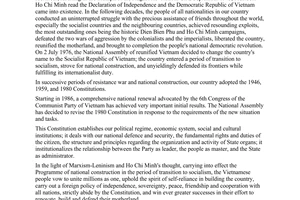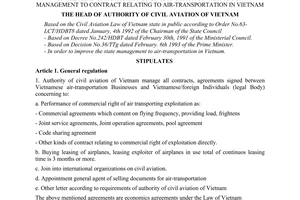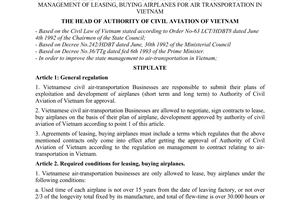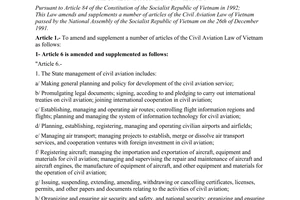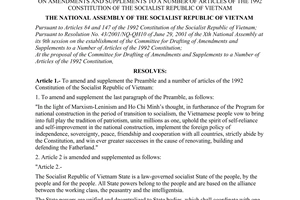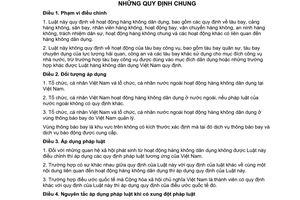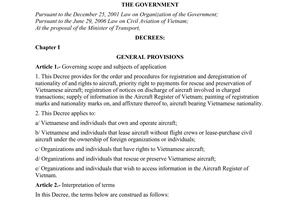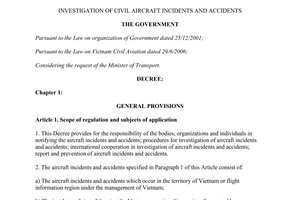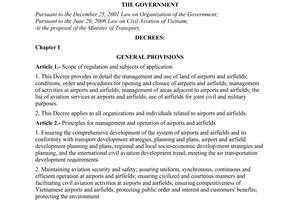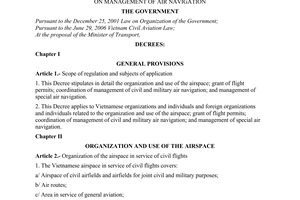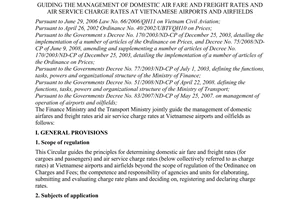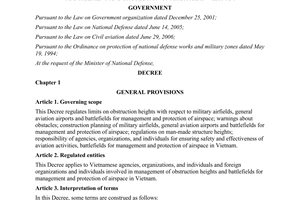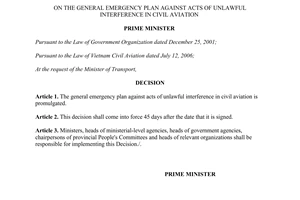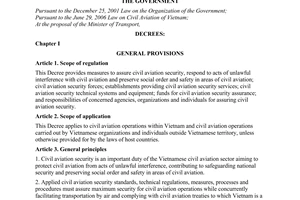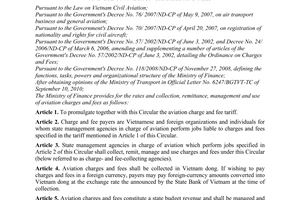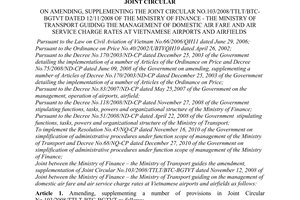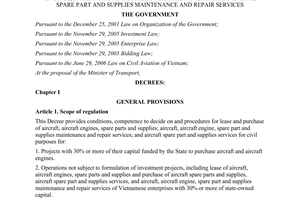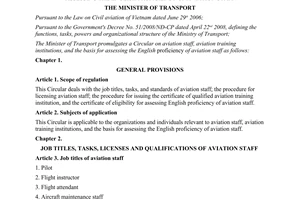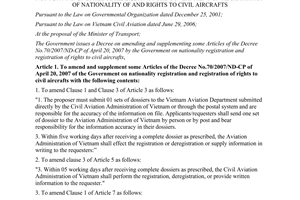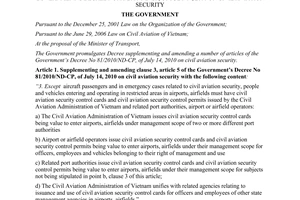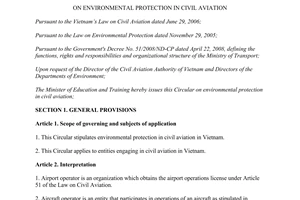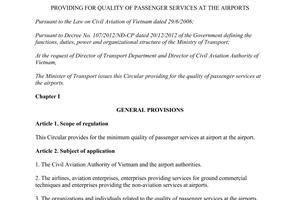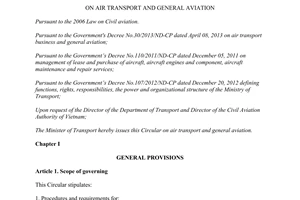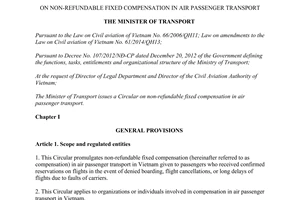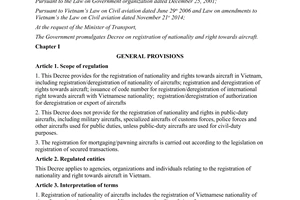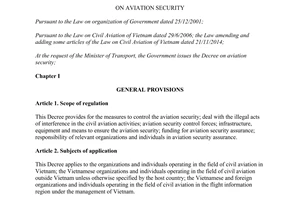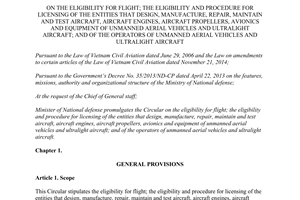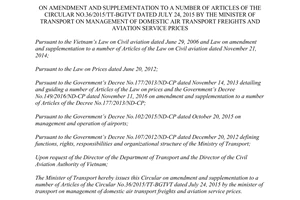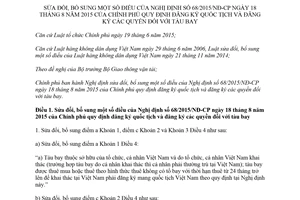Nội dung toàn văn Law No.66/2006/QH11 of June 29, 2006 Vietnam civil aviation
|
THE
NATIONAL ASSEMBLY |
OF VIET |
|
No: 66/2006/QH11 |
, June 29, 2006 |
LAW
CIVIL AVIATION
(No. 66/2006/QH11)
Pursuant to the 1992 Constitution of the Socialist
Republic of Vietnam, which was amended and supplemented under December 25, 2001
Resolution No. 51/2001/NQ-QH10 bổ sung điều của Hiến pháp nước cộng hoà xã hội chủ nghĩa Việt Nam năm 1992">51/2001/QH10 of the Xth National Assembly, the 10th session;
This Law provides for civil aviation.
Chapter I
GENERAL PROVISIONS
Article 1.- Scope of regulation
1. This Law provides for civil aviation activities, covering aircraft, airports, airfields, aviation personnel, air navigation, air carriage, aviation security, civil liability, general aviation and other activities related to civil aviation.
2. This Law does not provide for activities of official-duty aircraft, including military aircraft, specialized aircraft of customs and police forces and other aircraft used for state-duty purposes, except for cases where official-duty aircraft are used for civil purposes or other cases prescribed in the Vietnam Civil Aviation Law.
Article 2.- Subjects of application
1. Vietnamese organizations and individuals and foreign organizations and individuals engaged in civil aviation activities in .
2. Vietnamese organizations and individuals engaged in civil aviation activities in a foreign country, unless otherwise provided for by the laws of that foreign country.
3. Vietnamese organizations and individuals and foreign organizations and individuals engaged in civil aviation activities in the flight information region under the management of .
Flight information region means a delimited area in the air where flight information services and alarming services are provided.
Article 3.- Application of laws
1. For social relations arising from civil aviation activities not governed by this Law, relevant provisions of Vietnamese law shall apply.
2. When this Law and another law provide differently for the same issue related to civil aviation, the provisions of this Law shall apply.
3. When a treaty to which is a contracting party contains provisions different from those of this Law, the provisions of that treaty shall apply.
Article 4.- Principles of application of law in case of law conflicts
1. The laws of the state in which an aircraft's nationality is registered shall apply to social relations arising on board the aircraft in flight and to determining rights to an aircraft.
2. The laws of the state in which a contract related to rights to an aircraft is signed shall apply to determining the form of such contract.
3. The laws of the state in which an aircraft is salvaged or preserved shall apply to the payment of remuneration for the salvage or preservation of such aircraft.
4. The laws of the state in which an accident occurs as a result of aircraft collision or interference or in which an aircraft in flight causes damage to third parties on the surface shall apply to the compensation for damage.
Article 5.- Principles of civil aviation activities
1. Respect for independence, sovereignty, unity and territorial integrity of the Socialist Republic of Vietnam; assurance of safety and security of aviation; assurance of defense and security requirements and effective exploitation of aviation potential in service of national socio-economic development.
2. Compliance with the national socio-economic development strategy, the communications and transport development strategies, plannings and plans; coordinated development of airports, airfields, air navigation, means of transport and other resources; environmental protection and sustainable development.
3. Sound and fair competition among organizations and individuals of all economic sectors participating in civil aviation activities.
4. Expansion of international exchange and cooperation in the domain of civil aviation.
Article 6.- Policies on development of civil aviation
1. The State shall prioritize investment in construction and upgrading of airports, airfields and other facilities belonging to civil aviation infrastructure in order to ensure safe, efficient and coordinated development of air carriage.
2. The State shall create conditions for Vietnamese organizations and individuals of all economic sectors, foreign organizations and individuals and overseas Vietnamese to cooperate and invest in the domain of civil aviation.
3. The State shall facilitate Vietnamese airlines to provide air carriage services and exploit flight routes to areas with particularly socio-economic difficulties, mountainous, deep-lying and remote areas.
4. The State shall encourage research and application of scientific and technological advances and human resource training for civil aviation development.
5. The State shall protect legitimate rights and interests of organizations and individuals of all economic sectors engaged in civil aviation activities.
Article 7.- Environmental protection in civil aviation activities
1. Organizations and individuals engaged in civil aviation activities shall observe the environmental protection law.
2. Aircraft, air navigation facilities and equipment; airport and airfield facilities and equipment and other technical equipment on the ground shall meet environmental protection standards and be inspected in order to prevent and promptly respond to adverse environmental impacts.
Article 8.- Contents of state management of civil aviation
1. Promulgating legal documents, standards and processes related to civil aviation.
2. Formulating, and directing the implementation of, strategies, plannings, plans and policies on development of the civil aviation sector.
3. Managing civil flight operations within Vietnamese territory and in the flight information region, technical systems, air navigation facilities and equipment.
4. Planning and managing the operation of airports and airfields; assuming the prime responsibility for and coordinating activities of state management agencies and other organizations in airports and airfields.
5. Managing air carriage operations.
6. Registering aircraft and rights thereto.
7. Managing the design, manufacture, maintenance, import, export of aircraft, aircraft engines, aircraft propellers, aircraft equipment and other facilities, equipment and supplies in service of civil aviation activities.
8. Granting and recognizing certificates, permits and licenses and other papers and documents related to civil aviation activities.
9. Managing the assurance of security and safety for civil aviation activities; organizing and preserving security and safety for special flights and special-purpose flights.
10. Managing aircraft search and rescue activities and investigations into aircraft incidents and accidents.
11. International cooperation on civil aviation.
12. Managing the training and development of human resources for the civil aviation sector.
13. Managing scientific and technological activities in the civil aviation sector; environmental protection in civil aviation activities.
14. Supervising, inspecting, settling complaints and denunciations, and handling violations in civil aviation activities.
Article 9.- Responsibilities of state management of civil aviation
1. The Government shall perform the uniform state management of civil aviation.
2. The Ministry of Transport shall be responsible to the Government for performing the state management of civil aviation.
3. The Ministry of Defense shall manage and protect the Vietnamese airspace; supervise civil flight operations; and coordinate with the Ministry of Transport in organizing and using the airspace in service of civil aviation activities.
4. Ministries and ministerial-level agencies shall, within the scope of their respective tasks and powers, coordinate with the Ministry of Transport in performing the state management of civil aviation according to the Government's regulations.
5. People's Committees at all levels shall, within the scope of their respective tasks and powers, perform the state management of civil aviation in localities.
Article 10.- Aviation inspectorate
1. The aviation inspectorate, a body under the inspectorate of the Ministry of Transport, shall perform inspection specializing in civil aviation.
2. The aviation inspectorate has the following tasks and powers:
a/ Inspecting the observance of regulations on papers, documents, certificates and permits related to civil aviation; standards, processes and regulations on technical safety and conditions of aircraft, equipment for aircraft, airports and airfields, ensuring air navigation and other aspects of civil aviation;
b/ Suspending activities of organizations, individuals and means that violate aviation safety and security regulations or fail to meet technical standards and conditions of aviation safety and security;
c/ Sanctioning administrative violations in civil aviation in accordance with the law on handling of administrative violations;
d/ Detaining aircraft;
e/ Coordinating with inspectorates of ministries, ministerial-level agencies, government-attached agencies and concerned local agencies in detecting, stopping and handling acts that violate the civil aviation law;
f/ Suggesting measures to handle and redress violations in civil aviation activities.
3. The aviation inspectorate shall be equipped with uniforms, badges and necessary equipment.
4. The organization and operation of the aviation inspectorate shall comply with this Law and the inspection law.
Article 11.- Aviation service charges, fees and prices
1. Charges, fees and aviation service prices include:
a/ Charge for flight through the airspace, charge for the transfer of operation rights and other charges prescribed by the law on charges and fees;
b/ Fees for the grant of certificates and permits related to civil aviation activities;
c/ Prices of takeoff and landing services, administration of outbound and inbound flights; assistance in ensuring air navigation; security screening; and passenger services;
d/ Prices of other services provided at airports and airfields.
2. The Ministry of Finance shall set the rates of charges, fees and service prices specified at Points a, b and c, Clause 1 of this Article at the proposal of the Ministry of Transport.
3. Enterprises shall decide on prices specified at Point d, Clause 1 of this Article within the price frame set by the Ministry of Finance at the proposal of the Ministry of Transport.
Article 12.- Prohibited acts in civil aviation
a/ Using aircraft, aircraft engines, aircraft propellers and air navigation facilities and equipment without appropriate permits;
b/ Performing duties of aviation personnel without appropriate permits and certificates;
c/ Dropping equipment, items or other articles from aircraft in the air, thus affecting the safety of air navigation, environment and people's life;
d/ Flying into restricted or prohibited zones in contravention of regulations;
e/ Causing interference to, misusing and exploiting radio frequencies exclusively reserved for civil aviation activities;
f/ Damaging the system of signals, facilities, equipment, flight information and management stations, other facilities and equipment in airports and airfields or controlling or putting ground facilities failing to meet technical conditions into operation in the flight zones;
g/ Building architectural works, installing facilities and equipment or planting trees that may affect air navigation and the operation of facilities and equipment used in airspace and flight management;
h/ Building works in airports or airfields and their adjacent areas or installing facilities and equipment causing a lot of smoke, dust, fire or exhaust gas or building shooting ranges or works, installing other facilities and equipment that may affect the safety of flight and the operation of facilities and equipment in airports or airfields;
i/ Installing and using in airports or airfields or their adjacent areas lamps, beacons, signs, signals or objects that may affect aircraft takeoffs and landings at airports or airfields or the identification of airports or airfields;
j/ Feeding or rearing birds, cattle or poultry in the areas of airports or airfields;
k/ Illegally interfering in civil aviation activities;
l/ Taking weapons, inflammables, explosives and other dangerous things on board aircraft, into airports, airfields or other restricted zones in contravention of regulations;
m/ Destroying, damaging, deforming, displacing markers, separators, signal-bearing objects and protective objects in airports and airfields; damaging signs and equipment used for the identification of airports or airfields;
n/ Endangering the safety of air navigation, endangering the life, health and property of other persons on board aircraft;
o/ Acts of unfair competition and other banned acts of competition restriction.
2. The provisions of Point c and Point e, Clause 1 of this Article also apply to official-duty aircraft.
Chapter II
AIRCRAFT
Section 1. NATIONALITY OF AIRCRAFT
Article 13.- Registration of nationality of aircraft
1. Aircraft means a craft that can derive support in the atmosphere from the reactions of the air, including aircraft, helicopters, gliders, airships and other flying crafts, excluding those which derive support in the atmosphere from the reactions of the air against the earth's surface.
2. To register for Vietnamese nationality, an aircraft must fully meet the following conditions:
a/ Having no nationality of any state or having relinquished its foreign nationality;
b/ Having lawful papers evidencing its ownership;
c/ Conforming with technical standards set or recognized by competent state agencies.
3. Aircraft in course of manufacture, assembling or testing in shall be permitted for temporary registration to have Vietnamese nationality if they meet the conditions specified at Point b and Point c, Clause 2 of this Article.
4. Aircraft owned and operated by Vietnamese organizations or individuals must be registered to have Vietnamese nationality; in case of individuals, they must be permanent residents in .
5. Aircraft owned by foreign organizations or individuals and leased by Vietnamese organizations or individuals in the form of dry lease or hire-purchase shall be permitted for registration to have Vietnamese nationality according to the Government's regulations.
6. The aircraft register shall be opened publicly and used to record information on registration of nationality of aircraft. Organizations and individuals are entitled to request the grant of extracts or copies from the aircraft register at a fee.
7. An aircraft has Vietnamese nationality from the time it is recorded in the aircraft register. The Ministry of Transport shall issue aircraft nationality registration certificates.
8. Applicants for registration of aircraft to have Vietnamese nationality shall pay a fee.
Article 14.- Deletion of registration of nationality of aircraft
An aircraft shall has its Vietnamese nationality deleted in the following cases:
1. Being declared missing under Clause 3, Article 103 of this Law;
2. Being irreparably or irrestorably damaged;
3. Failing to meet the conditions specified in Clause 2, Article 13 of this Law;
4. At the proposal of the aircraft registrant.
Article 15.- Nationality and registration marks of aircraft
When operating, every aircraft must be painted or affixed with nationality and registration marks in accordance with the law of the state in which the aircraft's nationality is registered.
Article 16.- Specific provisions on nationality of aircraft
The order and procedures for registration and deletion of registration of Vietnamese nationality with respect to aircraft shall be stipulated by the Government.
Section 2. STANDARDS OF AIRWORTHINESS
Article 17.- Certificates of airworthiness
1. Aircraft shall be permitted for operation in the Vietnamese airspace only when they have valid certificates of airworthiness granted or recognized by the Ministry of Transport.
2. A certificate of airworthiness shall only be granted to an aircraft that meets all the following conditions:
a/ The aircraft is compatible with its class certificate;
b/ Having adequate facilities and equipment to ensure safety;
c/ Being operated and maintained according to regulations;
d/ Being in a state suitable to the expected operation purpose.
3. Applicants for certificates of airworthiness shall pay a fee.
4. Certificates of airworthiness of aircraft having foreign nationality shall be recognized provided that they are granted in accordance with standards prescribed or recognized by .
Article 18.- Class certificates
1. Class certificates shall be granted or recognized if the designs of aircraft, aircraft engines or aircraft propellers meet all airworthiness conditions prescribed or recognized by .
2. Applicants for class certificates shall pay a fee.
3. Aircraft, aircraft engines and aircraft propellers which are manufactured in or imported into must be compatible with class certificates granted or recognized by the Ministry of Transport.
Article 19.- Conditions on import and export of aircraft, aircraft engines, aircraft propellers and aircraft spare parts
1. To be-exported aircraft, aircraft engines and aircraft propellers must be granted certificates of airworthiness for export by the Ministry of Transport. Applicants for certificates of airworthiness for export shall pay a fee.
2. The import and export of aircraft, aircraft engines, aircraft propellers and aircraft spare parts must ensure aviation safety and security, national security and respond to business demands.
The age of used aircraft that are permitted for importation into shall be stipulated by the Government.
3. Aircraft, aircraft engines, aircraft propellers and aircraft spare parts which are imported for use as learning aids and other non-aviation purposes must not be used for civil aviation activities.
Article 20.- Design, manufacture, maintenance, test of aircraft, aircraft engines, aircraft propellers and aircraft equipment
1. The design, manufacture, maintenance or test of aircraft, aircraft engines, aircraft propellers and aircraft equipment in must comply with standards promulgated by competent state agencies.
2. Establishments engaged in designing, manufacturing, maintaining or testing aircraft, aircraft engines, aircraft propellers and aircraft equipment in must possess licenses granted by the Ministry of Transport. Applicants for those licenses shall pay a fee.
3. Aircraft having Vietnamese nationality, aircraft engines, aircraft propellers and aircraft equipment having Vietnamese nationality shall be maintained only at maintenance establishments and under maintenance programs already approved by the Ministry of Transport.
Article 21.- Specific provisions on airworthiness standards
The Minister of Transport shall issue regulations on airworthiness standards, procedures for grant, recognition of airworthiness conditions, grade certificates, criteria and procedures for licensing establishments engaged in designing, manufacturing, maintaining or testing aircraft, aircraft engines, aircraft propellers and aircraft equipment.
Section 3. OPERATION OF AIRCRAFT
Article 22.- Aircraft operators
1. Aircraft operators are organizations and individuals engaged in operating aircraft.
2. Aircraft-operating organizations may operate aircraft for commercial purposes when they are granted aircraft operator certificates or have their aircraft operator certificates recognized by the Ministry of Transport.
Aircraft-operating individuals may not operate aircraft for commercial purposes.
Article 23.- Aircraft operator certificates
1. An aircraft operator certificate shall be granted to an organization to certify its satisfaction of safe operation conditions for the prescribed class of aircraft and form of operation.
2. An organization shall be granted an aircraft operator certificate if meeting the following conditions:
a/ Having an appropriate organizational apparatus and mode of management and supervision of operation of aircraft;
b/ Having employees who have been adequately trained and have appropriate permits and certificates;
c/ Having a professional training program and an aircraft maintenance program suitable to the characteristics and scale of operation.
d/ Having aircraft, facilities and equipment ensuring safe operation;
e/ Having sufficient operation manuals.
3. Organizations applying for aircraft operator certificates shall pay a fee.
Article 24.- Responsibilities of the aircraft operator
1. To maintain a management system capable of supervising and monitoring the safe operation of aircraft.
2. To follow instructions in operation manuals.
3. To ensure ground facilities and services for the safe operation of aircraft.
4. To ensure that every aircraft in operation has sufficient crewmembers who have been adequately trained for each form of operation.
5. To observe requirements on aircraft maintenance and repair.
6. To strictly follow the provisions of the aircraft operator certificate, including the case of use of services and personnel under a contract of aircraft operation or maintenance assistance.
7. To strictly observe other regulations on aircraft operation.
Article 25.- Papers and documents carried in aircraft
1. An aircraft having Vietnamese nationality, when engaged in navigation, must carry the following papers and documents:
a/ Its nationality registration certificate;
b/ Its certificate of airworthiness;
c/ The aircraft operator certificate;
d/ Appropriate permits and certificates for its crewmembers;
e/ The journey log book;
f/ The permit for the use of radio equipment on board the aircraft, if installed;
g/ Flight manuals for the crew;
h/ A list of passengers, in case of carrying passengers;
i/ A manifest of cargo in case of carrying cargo;
j/ The certificate of civil liability insurance;
k/ Aircraft operation manuals.
2. Papers and documents specified in Clause 1 of this Article must be originals, except for the aircraft operator certificate.
3. Papers and documents carried in an aircraft having foreign nationality engaged in flights to and from must comply with the law of the state in which the aircraft is registered.
Article 26.- Requirements on environmental protection for aircraft and aircraft engines
An aircraft engaged in navigation must comply with requirements on environmental protection for aircraft and aircraft engines.
Article 27.- Specific provisions on aircraft operation
The Minister of Transport shall issue regulations on aircraft operation instructions, conditions, procedures and order for the grant of aircraft operator certificates, permits for use of radio equipment installed on aircraft; and requirements on environmental protection for aircraft and aircraft engines.
Section 4. RIGHTS TO AIRCRAFT
Article 28.- Rights to aircraft
1. Rights to aircraft include:
a/ Right to own aircraft;
b/ Right to possess aircraft through hire-purchase or lease for six months or more;
c/ Mortgage and pledge of aircraft;
d/ Other rights as provided for by the civil law.
2. The rights to aircraft specified in Clause 1 of this Article include rights to aircraft hulls, aircraft engines, aircraft propellers, aircraft radio equipment and other equipment used onboard aircraft, irrespective of whether they have been installed on board aircraft or temporarily removed therefrom.
Article 29.- Registration of rights to aircraft
1. Vietnamese organizations and individuals that have rights to aircraft specified in Clause 1 of Article 28 of this Law must register such rights according to the Government's regulations.
2. Applicants for registration of rights to aircraft shall pay a fee.
3. Matters related to registered rights to the same aircraft shall be entered in the aircraft register.
The registration of rights to aircraft specified in Clause 1 of this Article shall become valid from the time it is entered by the registration office in the aircraft register.
4. The transfer of the registration of rights to aircraft from to foreign countries is subject to approval of holders of such rights, unless the aircraft are sold for the enforcement of a legally effective court judgment or decision or arbitral award.
Article 30.- Transfer of ownership of aircraft
1. The transfer of aircraft ownership must be made in writing and shall become effective on the date it is entered in the aircraft register.
2. The transfer of ownership of an aircraft does not deprive of the priority right to receive remuneration for salvage and preservation of the aircraft, unless the aircraft is sold for the enforcement of a legally effective court judgment or decision or arbitral award.
enterprises assigned to manage and operate aircraft
A state enterprise assigned to manage and operate aircraft under state ownership has rights and obligations like an aircraft owner as provided for in this Law and the enterprise law.
Article 32.- Mortgage of aircraft
1. The mortgagor of an aircraft shall keep the original nationality registration certificate of the mortgaged aircraft.
2. The mortgage of an aircraft under common ownership is subject to written approval of its co-owners, unless otherwise agreed upon.
3. When an aircraft is mortgaged to several creditors, the order of mortgage shall be determined according to the time of registration of mortgage.
4. After prioritized debts have been paid off, creditors whose mortgage has been registered shall be paid with their debts in the order of registration.
5. A mortgaged aircraft is not entitled to transfer of ownership, unless it is so agreed by the mortgagee.
6. Aircraft mortgage registration shall be deleted in the following cases:
a/ The secured obligation terminates;
b/ The aircraft mortgage contract is cancelled;
c/ The aircraft used as mortgaged property has been disposed of;
d/ There is a legally effective court judgment or decision or arbitral award on the cancellation of the aircraft mortgage or declaring the aircraft mortgage contract invalid;
e/ At the request of the aircraft mortgagee.
7. When an insured mortgaged aircraft is missing or damaged, the mortgagee who has registered the mortgage is entitled to the insurance sum.
Article 33.- Payment of remuneration for aircraft salvage and preservation
1. Organizations and individuals involved in the salvage and preservation of aircraft have the priority right to remuneration for aircraft salvage and preservation and related expenses.
2. Within ninety days after the date of termination of the aircraft salvage and preservation, organizations and individuals involved in the aircraft salvage and preservation shall register their priority right to remuneration stated in Clause 1 of this Article according to the Government's regulations. Applicants for registration of the priority right to remuneration for aircraft salvage and preservation shall pay a fee.
3. Past the time limit specified in Clause 2 of this Article, the priority right to remuneration for aircraft salvage and preservation shall terminate, except in the following cases:
a/ Organizations and individuals involved in aircraft salvage and preservation have registered the priority right to remuneration for aircraft salvage and preservation;
b/ Organizations and individuals involved in aircraft salvage and preservation and those obliged to pay remuneration have reached agreement on the payable sum;
c/ Organizations and individuals involved in aircraft salvage and preservation have initiated a lawsuit regarding the payment of remuneration for aircraft salvage and preservation.
Article 34.- Priority debts
1. Priority debts shall be paid in the following order:
a/ Court fees and expenses for judgment enforcement;
b/ Remuneration for aircraft salvage and preservation and related expenses.
2. Debts specified at Point b, Clause 1 of this Article shall be paid in the order that the last debt shall be paid first.
Section 3. AIRCRAFT LEASE AND LEASE-OUT
Article 35.- Forms of aircraft lease and lease-out
1. Vietnamese organizations and individuals may lease or lease out aircraft for air carriage and other civil aviation activities.
2. Aircraft lease and lease-out take the following forms:
a/ Lease, lease-out with a crew.
b/ Lease, lease-out without a crew.
3. Aircraft lease or lease-out contracts must be made in writing.
Article 36.- Lease and lease-out of aircraft with a crew
1. In case of lease or lease-out of an aircraft with a crew, the aircraft shall be operated according to the lessor's aircraft operator certificate.
2. The lessor shall ensure safety standards of aircraft maintenance and operation.
Article 37.- Lease, lease-out of aircraft without a crew
1. In case of lease or lease-out of an aircraft without a crew, the aircraft shall be operated according to the lessee's aircraft operator certificate.
2. The lessee shall ensure safety standards of aircraft maintenance and operation.
3. When a Vietnamese organization or individual leases a foreign aircraft without a crew, if the lessee has special requirements on facilities and equipment on board the aircraft and communications and navigation equipment, such lease is subject to approval of the Ministry of Transport.
Article 38.- Requirements on aircraft lease
When making use of a leased aircraft, the lessee may not allow the lessor or any other related party to enjoy the lessee's economic benefits or use the lessee's rights to air carriage.
Article 39.- Acceptance of lease, lease-out of aircraft between Vietnamese organizations or individuals and foreign organizations or individuals
1. The lease or lease-out of an aircraft between a Vietnamese organization or individual and a foreign organization or individual is subject to written approval of the Ministry of Transport which shall take into account the following contents:
a/ Form of lease;
b/ Legal status of the parties to the aircraft lease contract;
c/ Lease term;
d/ Quantity, type and age of the leased aircraft;
e/ Nationality of the aircraft;
f/ Certificates related to the aircraft;
g/ Agreement on the purchase of civil liability insurance for passengers, baggage and cargo and for third parties on the surface;
h/ The organization responsible for operating and maintaining the aircraft according to the aircraft operator certificate.
2. The Vietnamese organization or individual leasing or leasing out an aircraft shall supply a copy of the lease or lease-out contract and other related documents upon request for consideration and approval; the Ministry of Transport shall give its reply within seven working days after receiving all of these documents.
3. Approval procedures stated in Clause 1 of this Article are not applicable to the lease of an aircraft for no more than seven consecutive days in the following cases:
a/ Substitution of other aircraft for making a special flight or requisition for other state-duty purposes;
b/ Substitution of an aircraft involved in an accident or having a technical breakdown;
c/ Substitution of an aircraft which cannot be operated for force majeure reasons.
The Vietnamese organization or individual leasing an aircraft under the provisions of this Clause shall notify in writing to the Ministry of Transport that the lessor has an appropriate aircraft operator certificate.
4. The Vietnamese organization or individual is obliged to liquidate the lease contract, re-export the leased aircraft or take the leased aircraft back to Vietnam when the lease-out contract ceases to be valid, the permit for temporary import of the leased aircraft or for the temporary export of the leased-out aircraft ceases to be valid or at the request of a competent state agency.
Article 40.- Transfer of obligations between the state in which aircraft are registered and the state of aircraft operators
1. In case of lease or lease-out of an aircraft between a Vietnamese organization or individual and a foreign organization or individual, the Ministry of Transport shall reach agreement with competent authorities of the state in which the aircraft is registered or the state of the aircraft operator concerned on receiving or transferring the obligations of the state in which the aircraft is registered in accordance with the Vietnamese law and treaties to which Vietnam is a contracting party.
State of the aircraft operator is the state in which the aircraft operator is headquartered, if the operator is an organization, or the state in which the aircraft operator permanently resides, if the operator is an individual.
2. The agreement stated in Clause 1 of this Article covers part or the whole of the obligation to comply with:
a/ Regulations on ensuring air navigation;
b/ Regulations on certificates of airworthiness;
c/ Requirements for crew members;
d/ Regulations pertaining to the installation and use of radio equipment on board aircraft.
Section 6. SUSPENSION OF FLIGHTS, DETENTION AND ARREST OF AIRCRAFT
Article 41.- Suspension of flights
1. An aircraft not yet taxing shall be suspended from making a flight when one of the following circumstances occurs:
a/ There arises an urgent circumstance necessitating the performance of the task of safeguarding national sovereignty and security or the aircraft is detected to show signs of violation of regulations on assurance of defense and security;
b/ Violation of regulations on airworthiness standards, operation of aircraft, aviation safety and security, flight formalities, making and implementation of flight schedules, and observance of flight permits;
c/ It is detected that aviation safety and security in the flight are under threat;
d/ Other cases as decided by competent state agencies.
2. In any circumstance specified at Points a, b and c, Clause 1 of this Article, the director of the airport authority or the aviation inspector shall make a written record thereon and issue a decision to suspend the flight. A decision to suspend a flight takes immediate effect and must be sent to the aircraft commander, the air traffic service establishment and concerned agencies and organizations.
3. When other competent agencies issue decisions to suspend a flight, such decisions take immediate effect. Decisions to suspend a flight must then be promptly sent to the authority of the airport from which the aircraft is due to take off.
4. Aircraft commanders and aircraft operators shall comply with decisions to suspend flights and may request agencies or persons who have made such decisions to give reasons for suspension.
5. The aircraft suspended from making flight may continue making flight after the grounds specified in Clause 1 of this Article no longer exist and competent state agencies have permitted the aircraft to make flight.
Article 42.- Request for aircraft to land at airports or airfields
1. An aircraft which is flying within the Vietnamese territory may be ordered to land at an airport or airfield when there are signs of threat to aviation safety and security during the flight or in other cases in which a competent state agency so orders.
2. If detecting signs of threat to aviation safety or aviation security during a flight the director of the airport authority may decide to order the aircraft concerned to land at an airport or airfield; such decision takes immediate effect.
3. When other competent agencies issue decisions to order an aircraft to land at an airport or airfield, such decisions take immediate effect. Decisions to order an aircraft to land must be promptly sent to the concerned air traffic service establishment and airport authority.
4. The concerned air traffic service establishment shall order an aircraft to land at an airport or airfield under the decision of the director of the airport authority or other competent agency. For the safety of a flight, the air traffic service establishment may refuse to comply with the decision to order an aircraft in flight to land at an airport or airfield and shall report its non-compliance to the agency which has issued such decision.
5. An aircraft which has landed at an airport or airfield as ordered may continue its flight when the grounds specified in Clause 1 of this Article no longer exist and it is so permitted by the competent state agency.
Article 43.- Detention of aircraft
1. An aircraft may be detained in the following circumstances:
a/ Violating national sovereignty and security of ;
b/ Failing to remedy violations specified at Point b, Clause 1, Article 41 of this Law or failing to comply with violation-handling measures;
c/ Committing banned acts related to air navigation, aircraft operation or air carriage;
d/ Violating relevant legal provisions on flight crews, passengers, baggage and cargo carried on board the aircraft;
e/ Other cases as decided by competent state agencies.
2. Upon detecting violations specified at Points a, b, c and d, Clause 1 of this Article, the director of the airport authority or the aviation inspector may detain the aircraft in violation. Decisions to detain an aircraft take immediate effect and must be sent to the aircraft commander, aircraft operator and concerned agencies and organizations.
3. When other competent agencies issue decisions to detain an aircraft, such decisions take immediate effect and must be promptly sent to the authority of the airport where the aircraft is due to make flight.
4. The detention of an aircraft terminates when the related violations have been handled in accordance with law or when the competent state agency having requested the detention proposes the termination of the detention.
Article 44.- Arrest of aircraft
1. Arrest of aircraft constitutes a measure taken by the court in the interest of creditors, owners or third parties who suffer damage on the surface or of other persons with rights and interests related to aircraft under the provisions of Clause 2 of this Article, except for arrest of aircraft for enforcement of legally effective court judgments or decisions or coercive decisions of competent state agencies. Arrest of aircraft may apply to any aircraft of the same owner.
2. The court of a province or centrally run city in which an aircraft has landed shall issue a decision to arrest the aircraft upon written request of the owner or a creditor, if the aircraft is an asset to secure a debt to the creditor or of third parties who suffer damage on the surface caused by the aircraft in flight or of persons having rights and interests related to the aircraft in accordance with this Law.
3. Requestors for arrest of aircraft shall provide financial assurance in the form and with the value fixed by the court which is equivalent to the damage possibly caused to the aircraft when it is arrested.
4. In case of arrest of an aircraft, the carrier or aircraft operator shall still perform its obligations committed in the contract.
5. The arrest of an aircraft terminates in the following circumstances:
a/ Debts have been paid off;
b/ Substitute security measures have been applied;
c/ The arrest requester proposes the termination of the arrest.
6. Procedures for arrest of aircraft shall be stipulated by the National Assembly Standing Committee.
Article 45.- Search of aircraft
1. Directors of airport authorities and other competent agencies shall decide to search an aircraft in the following cases:
a/ Signs of violating national sovereignty, national security, aviation security or safety are detected;
b/ Members of the flight crew, passengers or the carriage of baggage, cargo, postal items or other articles in the aircraft violate regulations on entry, exit, customs and quarantine.
2. Persons deciding to search an aircraft shall notify the aircraft commander and concerned agencies and organizations before conducting search.
3. Competent state agencies shall notify aircraft search decisions to the directors of airport authorities for coordination.
Article 46.- Liability to pay compensations for damage caused to aircraft operators or carriers
Organizations and individuals that have decided to suspend flights, requested aircraft to land at airports or airfields, detained, requested detention, requested arrest or search of aircraft in an illegal manner shall pay compensations for damage caused to aircraft operators or carriers.
Chapter III
AIRPORTS, AIRFIELDS
Section 1. GENERAL PROVISIONS
Article 47.- Airports, airfields
1. Airport is an area with specified boundaries, covering an airfield, terminals, facilities, equipment and other necessary structures used for aircraft making flights to, from and engaged in air carriage.
Airports are classified into the following categories:
a/ International airports, which serve international and domestic carriage;
b/ Domestic airports, which serve domestic carriage.
2. Airfield is an area with specified boundaries which is constructed for aircraft to land, take off and taxi. Airfields that are only used for either general aviation or carriage of passengers, baggage, cargo and postal items other than public carriage are specialized airfields.
Article 48.- Areas adjacent to airports and airfields
1. Airports and airfields shall have adjacent areas to ensure safety for civil aviation activities and inhabitants in such areas.
2. The boundary of areas adjacent to an airport and airfield is eight kilometers measuring from the boundary of the airport or airfield outward.
3. People's Committees at all levels shall assume the prime responsibility for, and coordinate with airport authorities and other competent agencies in, maintaining public order, ensuring the implementation of aviation safety and security regulations; applying measures to dismantle, destroy, remove or changing the structures of constructions, facilities, equipment or other obstacles in the adjacent areas of airports and airfields which endanger the safety of air navigation; preventing law-breaking acts and applying measures to protect the environment in these adjacent areas.
Article 49.- Opening and closure of airports and airfields
1. Opening or closure of an airport or airfield means permission or prohibition of operation of an airport or airfield under decision of a competent state agency.
2. The Prime Minister shall decide on the opening of airports or airfields in line with the planning on development of airports and airfields; on the closure of airports or airfields for security and defense assurance reasons or special socio-economic reasons.
3. The Minister of Transport shall decide on the temporary closure of airports and airfields in the following cases:
a/ Renovation, expansion or repair of airports and airfields, which can affect the safety of air navigation;
b/ Airport or airfield operation certificates are withdrawn;
c/ Natural calamities, epidemics, environmental pollution, aircraft accidents and other unexpected circumstances which endanger aviation safety and security.
4. When an unexpected incident occurs, in order to ensure aviation safety and security, the director of the airport authority shall decide to temporarily close the airport or airfield for no more than twenty four hours and immediately report the Minister of Transport thereon.
5. Airports or airfields shall be re-opened after the reasons specified in Clauses 2, 3 and 4 of this Article terminate.
Article 50.- Registration of airports and airfields
1. Airports and airfields must be registered in the airport and airfield register.
2. Conditions for being granted an airport or airfield registration certificate include:
a/ Having papers evidencing the lawful formation of the airport or airfield;
b/ Compliance with the approved planning on development of the system of airports and airfields;
c/ Having infrastructure conforming to technical standards prescribed or recognized by competent state agencies.
3. The Ministry of Transport shall register and grant registration certificates to airports and airfields.
4. Applicants for airport or airfield registration certificates shall pay a fee.
or airfield operation certificates
1. After an airport or airfield has been registered under Article 50 of this Law, its operator shall be granted an airport or airfield operation certificate when meeting all the following conditions:
a/ Meeting requirements on organization, facilities, equipment and other necessary factors for ensuring aviation safety and security;
b/ Ensuring technical standards of the airport or airfield and its adjacent areas .
2. An airport or airfield may be put into operation only after it is granted by the Ministry of Transport an airport or airfield operation certificate.
3. Applicants for airport or airfield operation certificates shall pay a fee.
4. An airport or airfield operation certificate shall be withdrawn in the following cases:
a/ The airport or airfield fails to meet the conditions specified in Clause 1 of this Article;
b/ The airport or airfield has not been operated or has ceased operation for twelve consecutive months;
c/ Other cases as decided by competent state agencies.
5. Organizations and individuals managing or operating airports or airfields shall comply with the provisions in their airport or airfield operation certificates.
Article 52.- Registration of airports and airfields under construction
1. Airports or airfields under construction may be temporarily registered in the airport and airfield register from the time of commencement of construction.
2. Conditions for an airport or airfield under construction to be granted an airport or airfield registration certificate include:
a/ Having lawful papers on land use rights and the construction of the airport or airfield;
b/ Compliance with the approved planning on development of the system of airports and airfields;
c/ Having a plan on construction of infrastructure conforming to technical standards prescribed or recognized by competent state agencies.
3. The Ministry of Transport shall register and grant registration certificates to airports or airfields under construction.
4. Applicants for registration certificates of airports or airfields under construction shall pay a fee.
Article 53.- Administration of takeoff and landing schedules at airports and airfields
1. Administration of takeoff and landing schedules at airports and airfields means management and allocation of takeoff and landing time of scheduled air carriage flights at airports or airfields as announced.
2. The Ministry of Transport shall administer takeoff and landing schedules at an airport and airfield on the following principles:
a/ Within the limits of operation of the airport or airfield;
b/ Ensuring publicity, transparency and non-discrimination;
c/ Convenience and efficiency;
d/ Compliance with international practice.
Article 54.- Environmental protection at airports and airfields
1. Organizations and individuals engaged in activities in airports or airfields shall implement regulations on environmental protection in airports and airfields.
2. The operation of aircraft, airports, airfields, air navigation facilities and equipment and other facilities and technical equipment on the ground, and the provision of services at airports and airfields must meet noise and exhaust gas standards and other standards for environmental protection in civil aviation activities.
Article 55.- Specific provisions on the opening and closure of airports and airfields and management of activities in airports and airfields and areas adjacent thereto
1. The Government shall stipulate conditions, order and procedures for opening and closure of airports and airfields and management of activities in airports and airfields, management of areas adjacent to airports and airfields, and use of airfields for joint civil and military purposes.
2. The Minister of Transport shall stipulate in detail the making of the airport and airfield register, procedures for the grant of airport and airfield registration certificates; procedures for the grant of registration certificates to airports and airfields under construction; technical standards of airports, airfields and areas adjacent thereto; procedures for the grant of airport and airfield operation certificates and requirements on environmental protection applicable to organizations and individuals operating in airports and airfields.
Section 2. PLANNING, INVESTMENT IN AND CONSTRUCTION OF AIRPORTS AND AIRFIELDS
Article 56.- Planning of airports and airfields
1. Planning of airports and airfields must be based on the socio-economic development strategy, defense and security tasks, development plannings of the transport sector and other sectors and localities, and the trend of development of international civil aviation.
2. The Ministry of Transport shall assume the prime responsibility for elaborating a planning on airports and airfields; submit to the Prime Minister for approval a master plan on development of the national system of airports and airfields and a detailed planning on international airports.
The Minister of Transport shall approve the detailed planning on domestic airports and airfields.
3. Sectors and localities, when making plannings or projects on investment in and construction of works which may affect the planning on airports and airfields, shall obtain written agreement of the Ministry of Transport.
Article 57.- Management of airport and airfield land areas
1. Airport and airfield land areas cover land areas for construction of airfields, terminals and necessary facilities to serve civil aviation activities at airports and airfields.
2. Airport authorities shall be assigned airport and airfield land areas at a time by provincial/municipal People's Committees according to the plannings already approved by competent state agencies. Airport and airfield land use certificates shall be granted to airport authorities.
3. Airport authorities may re-assign land areas without collection of land use levies or may lease land within the airport and airfield areas to organizations and individuals having demands for use of such land for proper purposes already approved by competent state agencies.
4. Organizations and individuals that lease airport and airfield land areas have the following rights and obligations:
a/ To use land areas for proper purposes, not to convert, transfer, donate, lease land use rights, mortgage, guarantee or contribute capital with the rights to use such land areas;
b/ To use their assets attached to the leased land areas for mortgage and guarantee at credit institutions licensed to operate in Vietnam; to sell, lease or contribute capital with, their own assets attached to the leased land areas.
Those who sell, lease, mortgage, guarantee or contribute capital with their assets attached to land shall ensure that such assets are used for proper purposes, in accordance with the planning and plan on development of airports and airfields and shall obtain the approval thereof from the Ministry of Transport.
Purchasers of the assets shall be leased land by the airport authorities and shall use such land and structures thereon for proper purposes already identified in the planning without affecting or disrupting the operation of airports and airfields.
5. The Government shall stipulate in detail the management and use of airport and airfield land areas.
Article 58.- Investment in and construction of airports and airfields
1. Investment in and construction of new airports or airfields or investment in and construction of structures in existing airports or airfields shall comply with the master plan on development of the system of airports and airfields and the detailed planning on airports and airfields already approved by competent state agencies.
2. Vietnamese and foreign organizations and individuals may invest in and construct airports and airfields in accordance with the investment and construction law.
Section 3. STATE MANAGEMENT IN AIRPORTS AND AIRFIELDS
authorities
1. Airport authority means an agency performing the state management of civil aviation in an airport or airfield.
2. The director is the head of the airport authority.
3. The Minister of Transport shall specify the organization and operation of airport authorities.
Article 60.- Tasks and powers of airport authorities
1. To manage the entire land areas of airports and airfields assigned to them for construction and development of airport and airfield infrastructures; to organize and manage the construction of facilities on the ground, water surface and under the ground in airports and airfields according to the plannings and projects already approved by competent state agencies.
2. To supervise and oversee the observance of regulations on:
a/ The implementation of plannings and plans on development of airports and airfields;
b/ Standards of aviation safety and security in airports and airfields and their adjacent areas;
c/ Public order and environmental protection in airports and airfields;
d/ Operation of air carriage in airports and airfields;
e/ Operation of airports and airfields as well as technical facilities and equipment therein;
f/ Provision of services for flights in airports and airfields;
g/ Use of airport and airfield land areas.
3. To coordinate with airport enterprises in implementing emergency and salvage plans and responding to aircraft incidents and accidents occurring in airports, airfields or areas adjacent thereto.
4. To decide to temporarily close airports and airfields.
5. To stop the construction and renovation of facilities, installation of equipment, planting of trees in airport and airfield areas; to propose competent state agencies to stop the construction and renovation of facilities, installation of equipment and planting of trees in areas adjacent to airports and airfields in violation of the planning on airports and airfields or regulations on management of obstacles which affects air navigation at airports and airfields.
6. To handle violations of law according to their competence;
7. To transfer to competent state agencies for settlement or coordinate with the latter in settling cases arising in airports and airfields;
8. To suspend flights; to order aircraft to land at airports or airfields; to search and detain aircraft; to execute warrants of arrest of aircraft; to stop acts of members of flight crews which fail to meet aviation safety and security requirements.
9. To collect, manage and use charges and fees in airports and airfields in accordance with the law on charges and fees.
10. To manage assets assigned by the State.
11. To assume the prime responsibility for arranging working offices of state management agencies regularly working in airports and airfields.
management activities in airports and airfields
1. Airport authorities and other agencies in airports and airfields shall perform professional activities and coordinate with one another in settling matters arising within the scope of their tasks and powers to ensure safety, security and regular activities in airports and airfields.
2. Airport authorities shall direct and coordinate activities of state management agencies in airports and airfields; convene and preside over monthly or irregular joint meetings of state management agencies and organizations operating in airports and airfields.
3. When related state management agencies in an airport or airfield fail to reach agreement on ways of settling a certain matter, the director of the airport authority shall make the final decision and take responsibility therefor.
4. When an airport or airfield is declared to be a zone affected by a dangerous epidemic, the airport authority shall coordinate with agencies and organizations operating in the airport or airfield area in applying appropriate measures to prevent the spread of the epidemic and stamp out the epidemic under the professional instructions of competent state agencies.
5. State management agencies regularly operating in airports and airfields shall be provided with appropriate working offices.
Section 4. OPERATION OF AIRPORTS AND AIRFIELDS
Article 62.- Organizations and individuals conducting business in airports and airfields
1. Organizations and individuals conducting business in airports and airfields include:
a/ Airport enterprises;
b/ Aviation service enterprises;
c/ Organizations and individuals providing other services.
2. The establishment and operation of business entities, activities of business individuals in airports and airfields shall comply with the provisions of this Law and the enterprise and commercial laws.
The Minister of Transport shall stipulate the order and procedures for the grant of airport business licenses and aviation service provision licenses.
3. Organizations and individuals conducting business in airports and airfields shall:
a/ Observe regulations on aviation safety and security;
b/ Comply with and facilitate airport authorities to supervise their business and service activities.
enterprises
1. Airport enterprises are enterprises conducting the conditional business of operation of airports and airfields.
2. An enterprise shall be granted by the Ministry of Transport an airport business license when meeting the following conditions:
a/ Having the business registration certificate;
b/ Having an organizational apparatus and employees who have appropriate licenses and certificates, and meeting professional requirements on operation of airports and airfields;
c/ Meeting capital conditions stipulated by the Government;
d/ Having a plan on facilities, equipment and other necessary conditions for ensuring aviation safety and security.
3. Enterprises applying for airport business licenses shall pay a fee.
Article 64.- Rights and obligations of airport enterprises
1. To manage and organize the operation of infrastructure, facilities and equipment of airports and airfields.
2. To make investment plans on the development, renovation and expansion of airports and airfields in accordance with the plannings already approved by competent state agencies, development demands and the operation of airports and airfields.
3. To organize the provision of aviation safety and security assurance services, aviation services and other public services in airports and airfields.
4. To report periodically or at the request of state management agencies data on annual and long-term production and business plans and results and statistics on the operation of airports and airfields.
5. To arrange working offices for state management agencies regularly working in airports and airfields at the request of airport authorities.
6. Other rights and obligations as provided for by the enterprise law.
Article 65.- Aviation service enterprises in airports and airfields
1. Enterprises providing aviation services in airports and airfields are enterprises conducting the conditional business of providing services directly related to aviation activities in airports and airfields and must possess aviation service provision licenses granted by the Ministry of Transport in accordance with the planning on development of airports and airfields.
2. An aviation service enterprise shall be granted an aviation service provision license when meeting the following conditions:
a/ Having the business registration certificate;
b/ Having an organizational apparatus ensuring the provision of services directly related to aviation activities in airports and airfields, and employees who have appropriate licenses and certificates, and meeting professional requirements for the operation of airports and airfields;
c/ Having facilities, equipment and other necessary conditions to ensure aviation safety and security;
d/ Meeting capital conditions stipulated by the Government.
3. Enterprises applying for aviation service provision licenses shall pay a fee.
4. The list of aviation services shall be issued by the Government.
Article 66.- Responsibilities of aviation service enterprises
1. To provide aviation services in airports and airfields under contracts signed with airport enterprises and to comply with regulations on operation of airports and airfields.
2. To provide quality services to customers in airports and airfields in a civilized, polite and thoughtful manner.
Article 67.- Right to select aviation service enterprises in airports and airfields
Air carriage enterprises are entitled to select aviation service enterprises in airports and airfields at their discretion, unless when the grounds of aviation safety and security are taken into account.
Chapter IV
AVIATION PERSONNEL
Section 1. GENERAL PROVISIONS
Article 68.- Aviation personnel
1. Aviation personnel are those personally involved in activities related to assurance of aviation safety and security, operation of aircraft, air carriage or air navigation and having appropriate professional licenses and certificates granted or recognized by the Ministry of Transport.
2. Aviation personnel are entitled to sign written labor contracts with their employing organizations.
3. Aviation personnel are entitled to interests and are obliged to perform obligations stated in their labor contracts and provided for by the labor law.
Article 69.- Professional licenses and certificates of aviation personnel
1. While on duty, aviation personnel shall carry appropriate licenses and certificates granted or recognized by the Ministry of Transport.
2. Apart from the provisions of Clause 1 of this Article, flight crew members, cabin crew member and air traffic controllers shall carry health certificates granted by competent medical establishments.
3. Aviation personnel shall be granted professional licenses and certificates after receiving training at professional training establishments permitted or recognized by the Ministry of Transport.
4. Applicants for aviation personnel's professional licenses and certificates shall pay a fee.
Article 70.- Specific provisions on aviation personnel, professional training establishments and medical establishments engaged in health assessment
1. The Minister of Transport shall issue detailed regulations on:
a/ Specific labor and labor discipline regimes for aviation personnel; for regulations on work time and rest time, which are subject to written agreement of the Ministry of Labor, War Invalids and Social Affairs;
b/ Titles, title-based tasks and criteria and procedures for the grant and recognition of professional licenses and certificates of aviation personnel;
c/ Standards and training programs of professional training establishments for aviation personnel.
2. The Ministry of Health shall assume the prime responsibility for, and coordinate with the Ministry of Transport in, prescribing health criteria for aviation personnel and for medical establishments engaged in examining the health of aviation personnel.
Section 2. CREW
Article 71.- Composition of crew
1. A crew consists of persons designated by the aircraft operator to perform duties during a flight.
2. A crew is composed of a flight crew, cabin crew members and other aviation personnel as required by the flight.
Article 72.- Flight crew
1. Flight crew members are those who navigate the aircraft, including the principal pilot, assistant pilot and other aviation personnel suitable to the aircraft class.
2. An aircraft may make a flight only when it has a full flight crew as required by the law of the state in which the aircraft is registered or by the law of the state of the aircraft operator.
Article 73.- Cabin crew members
1. Cabin crew members are those whose duty is to ensure safety for passengers during a flight and to provide services on board the aircraft according to the assignment of the aircraft operator or commander but who may not perform duties of flight crew members.
2. Specific duties of cabin crew members for each class of aircraft shall be assigned by the aircraft operator. Aircraft operators shall arrange a sufficient number of cabin crew members suitable to the class of aircraft.
Article 74.- Aircraft commanders
1. Aircraft commander is a member of the flight crew appointed by the aircraft operator for a flight; for aviation for non-commercial purposes, the aircraft commander shall be appointed by the aircraft owner.
2. The aircraft commander has the supreme power in the aircraft, and is responsible for ensuring aviation safety and security for the aircraft, persons and property in the aircraft in flight.
An aircraft shall be considered to be in flight from the moment when all its external doors are closed following embarkation until the moment when any of such door is opened for disembarkation; in case of a forced landing, the flight is deemed to continue until a competent state agency takes over the responsibility for the aircraft and for persons and property on board.
Article 75.- Rights of the aircraft commander
1. To decide on and take responsibility for the takeoff, landing, flight cancellation, return to the takeoff place or urgent landing.
2. To refrain from performing flight duties, flight plans or instructions of an air traffic service establishment in case of necessity to avert an instant and direct danger to air navigation and immediately report it to the air traffic service establishment.
In case of deviating the aircraft from the designated air route for the purpose of averting an instant and direct danger, after the danger is averted, the aircraft commander and the air traffic service establishment shall quickly apply every necessary measure to steer the aircraft back to its air route.
3. When the aircraft is in flight, to apply measures to stop persons from taking one of the following acts in the aircraft:
a/ Committing a crime;
b/ Endangering aviation safety and security;
c/ Attacking or threatening crew members or passengers;
d/ Failing to follow instructions of the aircraft commander or a crew member on behalf of the aircraft commander to ensure safety for the aircraft and maintain order and discipline in the aircraft;
e/ Destroying equipment and property in the aircraft;
f/ Abusing narcotics;
g/ Smoking in the aircraft toilets or no-smoking places, possibly endangering the safety of the aircraft;
h/ Using portable electronic devices, cellular phones or other electronic devices when the aircraft is taking off or landing or when it is banned for the safety of the flight;
i/ Other acts running counter to fine national customs and habits or violating public order.
4. To hand over persons committing acts specified in Clause 3 of this Article to competent state agencies after the aircraft lands at the nearest airport or airfield.
5. To decide to discharge fuel, drop baggage, cargo or other articles from the aircraft in accordance with Article 88 of this Law.
6. To issue necessary orders to everyone in the aircraft and continue performing his/her duties and powers till competent state agencies start to take over the aircraft, persons and property on board the aircraft in case of a forced landing.
7. To perform the following tasks in case of receiving no instructions or unclear instructions from the air operator and immediately notify the aircraft operator thereof:
a/ Paying necessary expenses for fulfilling the tasks of the flight, ensuring safety for persons and property during flight;
b/ Performing necessary tasks for the aircraft to continue the flight;
c/ Hiring laborers for a short term to perform jobs necessary for the flight.
Article 76.- Obligations of the aircraft commander
1. To obey instructions of the aircraft operator.
2. To take every necessary measure to ensure safety for the aircraft, persons and property in the aircraft in danger or in distress and to be the last leaving the aircraft.
3. When detecting persons, means of transport or other property in distress outside his/her aircraft, to notify the establishment which is providing air traffic services and to render assistance according to his/her ability without causing danger to his/her own aircraft, persons and property on board his/her own aircraft.
4. To take every necessary measure to steer the aircraft back to the designated air route when it deviates therefrom.
Article 77.- Interests of crew members
1. Interests of crew members working on an aircraft operated by a Vietnamese organization or individual are defined in their labor contracts and in accordance with the Vietnamese labor law.
2. The employer shall purchase accident insurance for flight crew members on duty.
3. If a crew member cannot continue performing his/her duties, the aircraft operator shall fully pay for his/her travel to the place designated in the contract or back to the place of his/her reception, unless otherwise agreed upon.
4. When a crew member stops working for aviation safety or security reasons as decided by the aircraft commander, his/her labor contract shall not be terminated. The aircraft operator shall bear all reasonable costs arising therefrom.
5. A labor contract shall terminate at the time agreed upon therein; if a labor contract terminates at a point of time when the crew member concerned is performing his/her duty, the time of termination of such contract is the time the flight crew member completes his/her duties.
6. If the aircraft operator notifies its unilateral termination of the labor contract when the crew member concerned is performing his/her duties, the time of notification shall be determined to be the time when the flight crew member completes his/her duties.
Article 78.- Obligations of crew members
1. To obey orders of the aircraft commander.
2. Not to leave the aircraft without the order of the aircraft commander.
Chapter V
AIR NAVIGATION
Section 1. MANAGEMENT OF AIR NAVIGATION
Article 79.- Organization and use of the airspace
1. The organization and use of the airspace must ensure requirements on defense, security and safety for aircraft, be reasonable and efficient and create favorable conditions for civil aviation activities.
2. The Prime Minister shall decide to establish and operate air routes.
Air route is an area in the air which is delimited in its elevation and width and under control.
3. The Ministry of Transport shall manage the organization and operation of air routes, the airspace of civil airfields, flight zones in service of general aviation in the Vietnamese airspace and the flight information region under the management of . The organization and operation of the airspace of an airfield used for joint civil and military purposes are subject to written agreement of the Ministry of Defense.
4. The provision of Clause 1 of this Article also applies to official-duty aircraft.
Article 80.- Management of flights in airports and airfields
1. Except for cases of forced landing, aircraft may take off from and land at lawfully opened airports and airfields.
2. Vietnamese and foreign aircraft making international flights may only take off from and land at international airports; if taking off from or landing at a domestic airport or airfield, the permission of the Prime Minister is required.
International flight referred to in this Law means flight made over the territories of more than one state.
Article 81.- Grant of flight permits
1. Flight permit means a written document or order which is granted by a competent state agency and determines conditions and permitted limits of operation of an aircraft.
2. Aircraft operating within the Vietnamese territory must obtain flight permits from one of the following Vietnamese agencies:
a/ The Ministry of Foreign Affairs, which grants flight permits to foreign special flights carrying guests invited by the Party and the State and escort or preparation flights in service of such special flights engaged in civil aviation activities in Vietnam.
Special flight means a flight for totally exclusive use or for exclusive use combined with commercial carriage which is certified or notified as such by a competent state agency according to regulations on service of special flights;
b/ The Ministry of Defense, which grants flight permits for flights of Vietnamese and foreign military aircraft engaged in civil aviation activities in and for flights of pilotless aircraft;
c/ The Ministry of Transport, which grants flight permits for flights engaged in civil aviation activities in Vietnam, including flights of Vietnamese and foreign aircraft for civil purposes; special flights of Vietnam, escort or preparation flights of such special flights; foreign special flights other than those specified at Point a of this Clause and escort or preparation flights of such special flights; and for flights of Vietnamese and foreign official-duty aircraft other than those specified at Points a and b of this Clause.
Article 82.- Conditions for grant of flight permits
1. The grant of flight permits for flights must satisfy requirements on defense, security, aviation security and safety; public order and interests; and must suit the capability of the air navigation assurance system, airports and airfields.
2. The grant of flight permits for scheduled commercial carriage flights must satisfy requirements specified in Clause 1 of this Article and be based on the granted air carriage rights.
Article 83.- Pre-flight, flight, and post-flight preparations
1. Aircraft commanders, organizations and individuals related to flight preparation shall strictly observe regulations on pre-flight, flight and post-flight preparation work.
2. Aircraft may take off from airports or airfields only after obtaining orders of air traffic service establishments.
3. The provision of Clause 2 of this Article also applies to official-duty aircraft.
Article 84.- Requirements on aircraft and crews operating in Vietnamese territory
1. When engaged in air navigation in Vietnamese territory, an aircraft must observe the following provisions:
a/ Flying according to the permitted journey, air route, flight region, point of entry and point of exit;
b/ Maintaining constant contact with the air traffic service establishment; observing the administration, control and instruction of such establishment;
c/ Landing at and taking off from airports and airfields designated in the flight permit, except for cases of forced or urgent landing;
d/ Complying with flight modes and the Regulation on civil air traffic.
2. The aircraft commander shall promptly report to the air traffic service establishment the following cases:
a/ His/her aircraft cannot fly according to the designated journey, air route, flight zone, point of entry or point of exit or land at the airport or airfield designated in the flight permit for objective reasons;
b/ There appear circumstances which prompt urgent landing and other emergency circumstances.
3. Air traffic service establishments and airspace management units of the Ministry of Defense shall promptly inform one another of the following cases for coordination in applying priority measures of assistance and instruction:
a/ Cases specified in Clause 2 of this Article;
b/ Where the aircraft loses contact or the crew loses the ability to control the aircraft.
Article 85.- Prohibited zones and restricted zones
1. Prohibited zone means a delimited area in the air where aircraft are banned to fly, except for Vietnamese official-duty aircraft on duty.
Restricted zone means a delimited area in the air where only aircraft that meet certain specific conditions can fly.
2. The Prime Minister shall decide on the establishment of prohibited zones and restricted zones in the Vietnamese territory for defense, security and social safety purposes.
In special cases for defense and security reasons, the Ministry of Defense shall decide on temporary flight restrictions or temporary flight bans in one or several areas in the Vietnamese territory; these decisions take immediate effect.
3. The Ministry of Defense shall stipulate the management of prohibited zones and restricted zones.
Article 86.- Dangerous zones
1. Dangerous zone means a delimited area in the air where air navigation may be endangered during specified periods of time.
2. Dangerous zones and the flight regime in these areas shall be determined by the Ministry of Defense and notified to the Ministry of Transport.
Article 87.- Flight over densely populated areas
1. When flying over densely populated areas, an aircraft must fly at elevations prescribed in the Regulation on civil air traffic.
2. Aircraft may not make exercise or training flights over densely populated areas, unless permitted by competent state agencies.
Article 88.- Discharge of fuel, drop of baggage, cargo or other articles from aircraft
An aircraft in flight may not discharge fuel or drop baggage, cargo or other articles from the aircraft. If, for reasons of safety for the flight or performance of rescue tasks in emergency circumstances or other flight tasks in public interests, an aircraft may discharge fuel or drop baggage, cargo or other articles from the aircraft in areas designated by the Ministry of Transport after consulting the Ministry of Natural Resources and Environment.
Article 89.- Announcement of aviation information
The Ministry of Transport shall publicly announce air routes, prohibited zones, restricted zones, dangerous zones, areas where air traffic services are provided, areas for aircraft to discharge fuel or drop baggage, cargo or other articles from aircraft.
Article 90.- Coercion of aircraft in violation
Aircraft that violate prohibited or restricted zones or violate the Regulation on civil air traffic, regulations on management of civil flights, management and use of the airspace and fail to obey orders of air traffic service establishments may be subject to the application of the measure of interception to force landing at an airport or airfield or other coercive measures applicable to aircraft. This provision also applies to official-duty aircraft.
Article 91.- Coordinated management of civil and military air navigation
1. Principles for coordinated management of civil and military air navigation include:
a/ Assurance of requirements on defense, security, safety and efficiency of civil aviation activities;
b/ Compliance with the provisions of this Law, for aircraft flying along the air routes, in the airspace of civil airfields or in the flight zones in service of general aviation in the airspace of Vietnam and the flight information region under the management of Vietnam;
c/ Performance of professional operations and settlement of matters arising within the scope of their tasks and powers.
2. Contents of coordinated management of air navigation include:
a/ Organizing the airspace and establishing air routes and developing flight modes;
b/ Using the airspace, managing civil flights outside air routes and the airspace of airfields;
c/ Granting flight permits, making flight plans and providing information on air navigation;
d/ Using air navigation assurance services;
e/ Conducting search and rescue;
f/ Managing special-purpose flights, including flights for photographing, geological survey, film shooting from the air, drilling, training and experimental flights using radio communication equipment other than equipment on board aircraft, and flights into restricted zones.
Article 92.- Management of obstacles
1. Management of obstacles means the making of statistics on, marking, announcement, management, grant of permits for use of the air and disposal of natural and artificial obstacles that may affect the safety of air navigation.
2. The Ministry of Transport shall publicly announce obstacle limitation surfaces in airfields; limited areas for ensuring the normal operation of aeronautical radio stations; the limits of obstacles in areas adjacent to airports and airfields and the list of natural and artificial obstacles that may affect the safety of air navigation.
3. Organizations and individuals building, managing or using high-rises, technical facilities and equipment, power transmission lines, technical radio equipment and other facilities which may affect the safety of air navigation shall affix identification signs and equipment thereto in accordance with this Law and bear all costs arising therefrom.
4. It is prohibited to build shooting ranges affecting aviation safety and to arrange the shooting direction of shooting ranges crossing air routes.
Article 93.- Management of frequencies
1. The management of frequency bands used by aeronautical radio stations and of aeronautical communication, navigation and surveillance systems shall comply with the telecommunications law.
2. Organizations and individuals using communication stations or other equipment must neither obstruct nor affect normal operations of aeronautical radio stations; must stop the use of, and promptly relocate their communication stations or equipment which obstruct and affect normal operations of aeronautical radio stations.
Article 94.- Specific provisions on management of air navigation
1. The Government shall stipulate in detail the
organization and use of the airspace, the grant of flight permits; coordinated
management of civil and military air navigation; management of special-purpose
flights; and management of obstacles.
2. The Ministry of Defense shall assume the prime responsibility for, and coordinate with the Ministry of Transport in stipulating modes of interceptive flight to force aircraft to land at airports or airfields, and other coercive measures applicable to aircraft.
3. The Ministry of Post and Telematics shall assume the prime responsibility for, and coordinate with the Ministry of Transport in, stipulating the management and use of radio frequencies of aeronautical operations.
Section 2. AIR NAVIGATION ASSURANCE SERVICES
Article 95.- Air navigation assurance services
1. Air navigation assurance services are necessary services to ensure safety, regularity, continuity and efficiency for air navigation, including air traffic service, aeronautical communication, navigation and surveillance service, meteorological service; aeronautical information notification service, and search and rescue service.
2. Air navigation assurance services are public ones.
3. Organizations and individuals conducting air navigation in the flight information region under the management of shall be provided with air navigation assurance services.
4. Enterprises providing air navigation assurance services must have service provision establishments and technical and equipment systems with operation permits granted by the Ministry of Transport. Enterprises applying for such operation permits shall pay a fee.
Article 96.- Air traffic services
1. Air traffic services include flight administration service, flight information service, air traffic consultancy service and alarming service.
2. Aircraft flying in a specified airspace must be administered by an air traffic service establishment.
3. Air traffic service establishments shall coordinate with concerned units in managing and administering civil aviation activities.
Article 97.- Air traffic service enterprises
1. Air traffic services are provided by state enterprises.
The establishment and operation of air traffic service enterprises shall comply with the provisions of this Law and the enterprise law. The Minister of Transport shall decide on the establishment of air traffic service enterprises.
2. An air traffic service enterprise may be established when all the following conditions are met:
a/ Compliance with the planning and strategy on development of the civil aviation sector;
b/ Having a plan on appropriate organizational apparatus;
c/ Having a plan on appropriate infrastructure and technical systems, equipment and facilities;
d/ Having a plan on employees who have appropriate permits and certificates for operating technical systems, equipment and facilities and operation manuals.
Article 98.- Rights and obligations of air traffic service enterprises
1. To provide fully and continuously air traffic services.
2. To provide other air navigation assurance services as assigned by the Ministry of Transport.
3. To maintain contact and closely collaborate with air traffic service establishments of neighboring states in providing flight administration services to ensure safety, regularity, continuity and efficiency for the operation of aircraft along air routes and in the flight information region under the management of Vietnam.
4. To comply with regulations on management, use and safeguarding of the airspace, the Regulation on civil air traffic and documents guiding air navigation assurance.
5. To closely coordinate with airspace management and flight management units under the Ministry of Defense in order to ensure safety for civil aviation activities.
6. To join and coordinate with concerned agencies and units in responding to circumstances of emergency or illegal interference in civil aviation activities and air defense operations.
7. To have other rights and obligations as provided for by the enterprise law.
Article 99.- Rights and obligations of enterprises engaged in providing communication, navigation and surveillance services, meteorological service, aeronautical information notification service, and search and rescue service
1. To provide aeronautical communication, navigation and surveillance service, meteorological service, aeronautical information notification service, and search and rescue service as assigned by the Ministry of Transport or as contracted.
2. To have other rights and obligations as provided for by the enterprise law.
Article 100.- Specific provisions on assurance of air navigation
The Minister of Transport shall stipulate in detail the organization and management of air navigation assurance activities; conditions and procedures for grant of operation licenses to establishments providing air navigation assurance services, and technical systems and equipment for air navigation assurance.
Section 3. SEARCH AND RESCUE
Article 101.- Notification of danger and distress
1. An aircraft shall be considered to be in danger when it is or persons on board are in a danger which crew members cannot overcome or when it loses communication and its location cannot be identified.
An aircraft shall be considered to be in distress if it has a serious breakdown when taxiing, taking off, flying or landing or it is completely destroyed or if it is forced to land outside an airfield.
2. An aircraft in danger or distress must release signals and notify the air traffic service establishment for assistance; when in danger or distress on the sea, it must also release signals to seagoing vessels and maritime rescue and search centers.
3. Upon receipt of signals, notices or reports on aircraft in danger or in distress, the air traffic service establishments shall immediately notify search and rescue service establishments thereof.
4. The provision of Clause 3 of this Article also applies to official-duty aircraft.
Article 102.- Coordination of search and rescue activities
1. Air traffic service establishments shall coordinate with rescue and salvage service establishments in applying every necessary measure in a timely manner to assist aircraft in danger or distress, passengers, crew members and property on board.
2. When an aircraft is in danger or distress at an airport, an airfield or an area adjacent thereto, the airport authority shall coordinate with the search and rescue service establishment and People's Committees at all levels in searching for and rescuing the aircraft, persons and property.
3. When an aircraft is in danger or distress outside areas specified in Clause 2 of this Article, the search and rescue service establishment shall coordinate with People's Committees at all levels and other agencies and organizations in searching for and rescuing the aircraft, persons and property.
4. The search for and rescue of an aircraft having Vietnamese nationality in danger or distress in the territory of a foreign state shall comply with the laws of the state in which the aircraft is in danger or distress.
5. The coordination of assistance and participation in search and rescue between and neighboring states shall comply with treaties to which is a contracting party.
6. People's Committees at all levels shall participate in civil aviation search and rescue, preserve aircraft and property on board which are in distress in localities outside airport or airfield areas.
7. Air carriage enterprises shall participate in air search and rescue at the request of search and rescue service establishments.
Article 103.- Search and rescue responsibilities
1. Air traffic service establishments and search and rescue service establishments shall immediately conduct search for aircraft in danger or distress.
2. When all available measures have been taken to search for an aircraft in distress, its passengers and crew but are in vain, the Ministry of Transport shall decide to terminate operations to search for such aircraft.
3. An aircraft shall be considered missing from the date there is a decision on termination of search operations.
4. The aircraft operator shall remove the aircraft from the place where it is crashed at the request of a competent state agency and shall bear all related expenses.
Section 4. INVESTIGATION INTO AIRCRAFT INCIDENTS AND ACCIDENTS
Article 104.- Aircraft incidents and accidents
1. Aircraft incident is an occurrence, other than an aircraft accident, associated with the operation of an aircraft which affects or would affect the safety of operation of the aircraft.
2. Aircraft accident is an occurrence associated with the operation of an aircraft which takes place between the time any person boards the aircraft with the intention of flight until such time as all such persons have disembarked, in which:
a/ A person suffers a fatal or serious injury as a result of being in the aircraft direct contact with any part of the aircraft, including parts which have become detached from the aircraft, or direct exposure to jet blast, except when the injuries are from natural causes, self-inflicted or inflicted by other persons, or when the injuries are to stowaways hiding outside the areas normally available to the passengers and crew;
b/ The aircraft sustains damage or structural failure which adversely affects the structural strength, performance or flight characteristics of the aircraft, and would normally require major repair or replacement of the affected component, except for engine failure or damage, when the damage is limited to the engine, its cowlings or accessories; or for damage limited to propellers, wing tips, antennas, tyres, brakes, fairings, small dents or puncture holes in the aircraft skin;
c/ The aircraft is missing or is completely inaccessible.
Article 105.- Purposes of and procedures for investigation into aircraft incidents and accidents
1. An aircraft incident or accident occurring in the Vietnamese territory must be investigated. An incident or accident occurring outside the Vietnamese territory to an aircraft having Vietnamese nationality or an aircraft operated by a Vietnamese organization or individual shall be investigated in accordance with treaties to which the Socialist Republic of Vietnam is a contracting party.
2. Aircraft incident or accident investigation aims to identify the incident or accident causes and measures to be applied to prevent future incidents and accidents.
3. The Government shall stipulate procedures for investigation into aircraft incidents and accidents.
Article 106.- Responsibilities for investigating into aircraft incidents and accidents
1. When an aircraft incident occurs in the Vietnamese territory or the flight information region under the management of , depending on the characteristics of the incident, the Ministry of Transport shall perform its reporting responsibility in accordance with treaties to which the Socialist Republic of Vietnam is a contracting party.
2. When an aircraft accident occurs in the Vietnamese territory or the flight information region under the management of Vietnam, the Ministry of Transport shall report it to the International Civil Aviation Organization and notify the state in which the aircraft is registered, the state of the aircraft operator, the state of manufacture of the aircraft, the state in which the aircraft is designed and other related states in accordance with treaties to which the Socialist Republic of Vietnam is a contracting party.
3. Competence to organize investigations into aircraft incidents or accidents is as follows:
a/ The Ministry of Transport shall organize investigations into aircraft incidents or accidents stipulated in Clause 1 and at Point b, Clause 2, Article 104 of this Law; and coordinate with agencies managing official-duty aircraft in investigating accidents related to official-duty aircraft;
b/ The aircraft accident investigation committee set up by the Prime Minister shall organize investigations into aircraft accidents specified at Points a and c, Clause 2, Article 104 of this Law.
4. When an aircraft accident occurs, the accident investigation agency has the following duties:
a/ To investigate to clarify the event, conditions, circumstances, cause and extent of the damage caused by the accident;
b/ To apply measures to restrict any possible damage;
c/ To publicize in time information and documents related to the accident;
d/ To coordinate with concerned agencies and organizations as well as local authorities in investigating the accident and give guidance on prevention of future aircraft accidents.
5. The Prime Minister shall decide to accept representatives from the state in which the aircraft is registered and the state of the aircraft operator to join in the capacity as observers in investigating accidents of foreign aircraft occurring in the Vietnamese territory.
Article 107.- Rights of agencies investigating into aircraft incidents and accidents
1. When conducting investigations, the aircraft incident or accident investigation agency has the following rights:
a/ To get on board the aircraft to clarify details of the incident or accident;
b/ To check and examine the aircraft, equipment, devices and property in the aircraft suffering the incident or accident and any related aircraft and property;
c/ To authorize capable agencies and organizations to conduct research and perform jobs related to the aircraft incident or accident investigation;
d/ To requisition capable persons to verify matters related to the aircraft incident or accident;
e/ To study matters related to the aircraft incident or accident, training and coaching of aviation personnel, flight assurance and making; psychology and constitution of crew members and related aviation personnel;
f/ To request, receive and study information and documents from agencies, organizations and individuals involved in the aircraft incident or accident.
2. In case of a fatal accident, the aircraft accident investigation agency has the right to decide to keep bodies of dead persons for investigation purposes.
Article 108.- Responsibilities for notifying and protecting evidence
1. Agencies, organizations and individuals shall promptly report information on aircraft incidents or accidents to local authorities, search and rescue service establishment or an agency or unit in the aviation sector in the nearest place and help search and rescue persons, property and protect aircraft in distress.
Local People's Committees receiving information on aircraft incidents or accidents shall promptly notify the Ministry of Transport thereof.
2. Related agencies, organizations and individuals shall protect aircraft suffering incidents or accidents and equipment, devices and property on board to serve investigation work and hand over evidences to the aircraft incident or accident agency or the local People's Committee in the nearest place.
3. Those who deliberately conceal information on an aircraft incident or accident, distort information, damage or destroy checking equipment and other evidences related to an aircraft incident or accident shall, depending on the nature and seriousness of their acts, be administratively sanctioned or examined for penal liability.
4. The provisions of Clauses 1, 2 and 3 of this Article also apply to official-duty aircraft.
Chapter VI
AIR CARRIAGE
Section 1. AIR CARRIAGE ENTERPRISES
Article 109.- Air carriage business
1. Air carriage means carriage of passengers, baggage, cargo and postal items by air. Air carriage includes scheduled carriage and non-scheduled carriage.
Scheduled air carriage means carriage by air on scheduled flights, according to announced flight schedules and publicly opened to public use.
Non-scheduled air carriage means air carriage which does not have all elements of scheduled air carriage.
2. Air carriage business means a conditional business line conducted by air carriage enterprises (hereinafter referred to as airlines).
Article 110.- Conditions for grant of air carriage business licenses
1. An enterprise may be granted an air carriage business license when fully meeting the following conditions:
a/ Having a business registration certificate showing that the major business line is air carriage;
b/ Having a plan on assurance of the availability of aircraft for operation;
c/ Having an organizational apparatus, employees who have appropriate permits and certificates and are capable of operating aircraft and dealing in air carriage;
d/ Meeting capital conditions as stipulated by the Government;
e/ Having a business plan and a strategy on development of air carriage products in accordance with market demands and aviation sector development plannings and orientations;
f/ Having a head office and principal place of business in .
2. A foreign-invested enterprise may be granted an air carriage business license when fully meeting the conditions specified in Clause 1 of this Article and the following conditions:
a/ The foreign party's capital contribution proportion complies with regulations of the Government;
b/ The enterprise's representative by law is a Vietnamese citizen and foreigners account for not more than one third of the total number of members of its executive apparatus.
3. The Minister of Transport shall grant air carriage business licenses after obtaining permission of the Prime Minister.
4. Enterprises applying for air carriage business licenses shall pay a fee.
5. The Government shall specify conditions, order and procedures for the grant of air carriage business licenses.
Article 111.- Carriage rules
1. Carriage rules constitute an integral part of an air carriage contract, stipulating the carrier's conditions of carriage by air of passengers, baggage, cargo and postal items .
2. Carriage rules must not contravene the provisions of this Law and treaties to which the Socialist Republic of Vietnam is a contracting party.
3. Airlines shall issue their carriage rules and register them with the Ministry of Transport.
Section 2. OPERATION OF AIR CARRIAGE
Article 112.- Right to air carriage
1. Right to air carriage means the right to commercially operate air carriage under conditions on airlines, air routes, aircraft in operation, flights and subjects of carriage.
2. Airlines shall deal in air carriage within the scope of the right to air carriage defined by the Ministry of Transport, and may not buy or sell this right or commit banned acts of competition restriction or unfair competition.
3. Airlines may carry out trade promotion activities and deal in air carriage after they are granted by the Ministry of Transport the right to air carriage.
Article 113.- Procedures for grant of the right to air carriage
1. Vietnamese airlines applying for the right to air carriage shall send dossiers to the Ministry of Transport. Such a dossier comprises:
a/ An application for the right to air carriage;
b/ The aircraft operator's certificate;
c/ A report on proposed air routes and operation plan;
d/ Documents certifying the legal person status and operation charter of the airline.
2. Foreign airlines applying for the right to scheduled air carriage shall send dossiers to the Ministry of Transport. Such a dossier comprises:
a/ Documents specified in Clause 1 of this Article;
b/ A document issued by the state of the foreign airline designating, or certifying the designation of, such airline to have the right to operate air carriage in accordance with treaties to which the Socialist Republic of Vietnam is a contracting party.
3. The Ministry of Transport shall consider and decide whether or not to grant the right to scheduled air carriage within ten working days after the date of receipt of complete dossiers.
4. An airline has its right to scheduled air carriage revoked in the following cases:
a/ Seriously violating the provisions of law on assurance of aviation safety, aviation security and operation of air carriage;
b/ Failing to start air carriage within twelve months after the date of grant of the right to air carriage;
c/ Ceasing air carriage for twelve consecutive months;
d/ As provided for by treaties to which the Socialist Republic of Vietnam is a contracting party.
5. The right to non-scheduled air carriage shall be granted together with flight permits.
6. Vietnamese airlines shall supply copies of cooperation contracts directly related to the right to air carriage and relevant documents to the Ministry of Transport for consideration and approval. The time limit for consideration and approval of contracts is seven working days, counting from the date of receipt of all of these documents.
Article 114.- Right to international air carriage
1. International air carriage is carriage by air over the territories of more than one state.
The exchange of the right to air carriage between and other states must ensure fairness and equality in the opportunity to operation and in the interests and obligations between Vietnamese and foreign airlines.
2. The right to scheduled international air carriage to and from shall be granted on the basis of market demand, the capability of airlines, the balanced development of flight route networks, on the basis of and in accordance with treaties to which the Socialist Republic of Vietnam is a contracting party. When does not yet accede to a treaty on air carriage, the Minister of Transport may permit airlines to temporarily operate scheduled international air carriage to and from .
3. The right to non-scheduled international air carriage to and from shall be granted on the basis of market demand without adversely affecting scheduled carriage.
Article 115.- Right to domestic air carriage
1. Domestic air carriage is carriage by air within the territory of a state.
2. The right to domestic air carriage shall be granted to Vietnamese airlines on the basis of market demand, the capability of these airlines, the balanced development of air route networks, and national socio-economic development objectives.
3. The Ministry of Transport shall designate Vietnamese airlines, which are state enterprises, to operate air routes to areas with particularly difficult socio-economic conditions, mountainous, deep-lying and remote areas where there are essential needs for public air carriage.
4. A foreign airline may participate in domestic air carriage after it obtains permission of the Minister of Transport in the following cases:
a/ Prevention or combat of natural calamities or epidemics;
b/ Supplying emergency humanitarian relief.
Article 116.- Air carriage freight rates
1. Airlines shall notify air carriage freight rates for international routes to and from upon request of the Ministry of Transport, unless otherwise provided for by treaties to which the Socialist Republic of Vietnam is a contracting party.
2. Domestic air carriage freight rates shall be decided by airlines within the freight rate frame prescribed by the Ministry of Finance at the request of the Ministry of Transport.
Article 117.- Combined carriage
1. In case of combined carriage performed partly by air and partly by any other mode of carriage, the provisions of this Law shall only apply to the carriage by air.
2. Parties to an air carriage contract may indicate in air waybills, cargo receipts and passenger tickets conditions relating to other modes of carriage.
Article 118.- Successive carriage
1. In case of air carriage performed by various successive carriers, each of such successive carriers shall be deemed to be one of the parties to the carriage contract.
2. In case of passenger carriage, passengers or persons entitled to claim compensation may initiate a lawsuit against any successive carrier which performed the carriage during which the accident or the delay occurred, unless the first carrier has assumed liability for the whole journey.
3. In case of carriage of baggage or cargo, the passenger or consignor is entitled to initiate a lawsuit against the first carrier; and the passenger or consignee is entitled to initiate a lawsuit against the last carrier; each carrier may initiate a lawsuit against the carrier which performed the carriage during which the loss, lack, damage or delay took place. These carriers must be jointly and severally liable to the passenger or to the consignor or consignee.
Article 119.- Simplification of procedures in air carriage
1. Aircraft, crews, passengers, baggage, cargo and postal items to and from shall be facilitated in entry, exit, customs, quarantine and other inspection procedures.
2. Related organizations and individuals shall supply devices, equipment and services to ensure the quick clearance of air carriage, exit, entry, customs, quarantine and other inspection procedures for aircraft, crews, passengers, baggage, cargo and postal items at airports or airfields.
3. Passengers, baggage, cargo and postal items in transit in without departing from the transit lounge are exempt from entry, exit and customs procedures.
Article 120.- International carriage involving many points in
1. International carriage involving many points in means international air carriage involving at least two points of arrival or two points of departure in the Vietnamese territory.
2. During international carriage involving many points in Vietnam, at the first point of arrival and the last point of departure, aircraft, crews, passengers, baggage, cargo and postal items are subject to regulations applicable to air carriage, entry, exit, customs and quarantine procedures at international transit points, unless otherwise provided for by law.
Article 121.- Reporting and supply of statistical data
1. Vietnamese airlines shall report to the Ministry of Transport on a periodical basis or upon request on their long-term and annual production and business plans and results and supply statistics on air carriage.
2. Foreign airlines operating in shall supply relevant statistics on air carriage at the request of the Ministry of Transport.
3. Statistics on air carriage include statistics on passengers, cargo and postal items already carried, on aircraft fleet and flight crew members, and on the financial status.
Article 122.- Air carriage service business
1. Vietnamese and foreign airlines may sell or deliver passenger tickets or air waybills directly at ticket sale offices or agents on the basis of agent designation contracts or via e-transactions.
Ticket sale offices are branches of an airline which perform the duty of selling its tickets.
2. Foreign airlines dealing in air carriage services in may make payments, convert and remit foreign currencies abroad in accordance with Vietnamese laws and treaties to which the Socialist Republic of Vietnam is a contracting party.
Article 123.- Conditions and procedures for opening representative offices and ticket sale offices of foreign airlines
1. A foreign airline may open representative offices or ticket sale offices in when meeting the following conditions:
a/ Having been established and operating by the law of the state in which the airline is headquartered;
b/ The right to legal control rests with the state in which the airline is headquartered.
2. A foreign airline wishing to open representative offices or ticket sale offices shall send a dossier to the Ministry of Transport. Such a dossier comprises:
a/ An application for a permit for the opening of a representative office or ticket sale office;
b/ Document certifying the airline's legal person status and its operation charter;
c/ Written certification of the conditions specified in Clause 1 of this Article, issued by competent authorities of the state in which the airline is headquartered, except for airlines which have been granted the right to scheduled air carriage to Vietnam;
d/ Papers certifying the right to use the house where the representative office or ticket sale office is to be based;
e/ Forms of tickets expected to be sold or delivered in .
3. The Ministry of Transport shall consider and decide whether to grant permits for the opening of representative offices or ticket sale offices to foreign airlines within seven working days after the date of receipt of complete dossiers stated in Clause 2 of this Article.
4. Foreign airlines applying for permits for the opening of representative offices or ticket sale offices shall pay a fee.
5. The permit for the opening of a representative office or ticket sale office granted to a foreign airline shall be revoked in the following cases:
a/ Failing to meet the conditions specified in Clause 1 of this Article;
b/ Failing to commence operation within twelve months from the date of grant of the permit;
c/ Ceasing the sale of tickets for twelve consecutive months;
d/ Operating for improper purposes or in contravention of the contents of the permit;
e/ Committing acts of cheating customers;
f/ Seriously breaching regulations on air carriage business or operation of the computerized booking system;
g/ In case of necessity to guarantee Vietnamese airlines' right to open similar representative offices or ticket sale offices in the state in which the foreign airlines are based.
Article 124.- Rights and obligations of foreign airlines' representative offices and ticket sale offices
1. To operate for proper purposes, within the scope and the term indicated in their permits.
2. To lease offices, lease and procure equipment and articles necessary for their operation.
3. To recruit employees who are Vietnamese or foreigners to work at the offices in accordance with the Vietnamese law on labor.
4. To open accounts for foreign currency amounts and Vietnamese currency amounts of foreign origin at banks operating in and use such accounts for the offices' activities only.
5. To have a seal bearing the name of the office in accordance with the Vietnamese law on enterprises.
6. Representative offices may not conduct activities which generate profits directly in , enter into contracts, except for the cases specified in Clauses 2, 3 and 4 of this Article, amend or supplement contracts already entered into by their airlines, except for contracts entered into by themselves or when their chiefs have a lawful authorization paper issued by their airline.
7. To pay taxes, charges and fees, fulfill financial obligations and implement the accounting regime in accordance with Vietnamese law.
8. To report on their activities on a periodical basis or upon request to the Ministry of Transport.
Article 125.- Conditions, procedures for, and registration of contracts on, designation of ticket sale agents of foreign airlines
1. Foreign airlines wishing to designate ticket sale agents in must meet the conditions specified in Clause 1, Article 123 of this Law.
2. Ticket sale agents of foreign airlines may sell tickets only after they register contracts on designation of ticket sale agents with the Ministry of Transport.
3. A dossier of contract registration comprises:
a/ An application for registration of the contract on designation of ticket sale agent;
b/ Document certifying the airline's legal person status and its operation charter;
c/ The notarized contract on designation of ticket sale agent;
d/ The ticket sale agent's business registration certificate.
4. The Ministry of Transport shall consider and decide whether to grant certificates of registration of contracts on designation of ticket sale agents within seven working days after the date of receipt of complete dossiers stated in Clause 3 of this Article.
5. Ticket sale agents of foreign airlines shall pay a fee.
Article 126.- Computerized booking systems
1. Computerized booking system is a computerized system supplying information on flight schedules, the situation of seats on flights and air carriage freights, through which the booking of seats on flights is effected.
2. An enterprise dealing in a computerized booking system shall abide by the following principles:
a/ Equality and non-discrimination among service users;
b/ Users shall not be forced to use its services or equipment only;
c/ The display of information on the computer monitor on flight schedules, the situation of seats on flights and air carriage freights must be complete, fair and non-discriminatory;
d/ Service charges must be set on the basis of reasonable costs and applied to all users without discrimination;
e/ Customers' personal information shall be kept secret, unless upon request of competent state agencies.
Article 127.- Supervision and inspection of operation of air carriage
Vietnamese and foreign airlines operating in shall submit to the supervision and inspection by the Ministry of Transport in their implementation of regulations on operation of air carriage and assurance of aviation safety and security.
Section 3. CARRIAGE OF CARGO
Article 128.- Contract of cargo carriage
1. Contract of cargo carriage is an agreement between the carrier and carriage hirer, whereby the carrier is obliged to carry cargo to the place of destination and deliver cargo to the entitled consignee; and the carriage hirer is obliged to pay carriage freight.
The carrier is an organization providing the service of commercial carriage by air.
2. Air waybills and other written agreements between the parties, carriage charters and freight rate tables are documents of contracts of cargo carriage.
Article 129.- Air waybills and cargo receipts
1. Air waybill is a document of cargo carriage by air and constitutes an evidence of the conclusion of the contract, the receipt of the cargo and the acceptance of the conditions stated in the contract.
2. Air waybills must be used for the carriage of cargo by air. In case a means which preserves the information on the carriage of cargo is substituted for the delivery of an air waybill, the carrier shall, if so requested by the consignor, deliver to the consignor a cargo receipt permitting identification of the cargo.
3. The carrier shall pay compensations to the consignor for damage caused due to the fault of the carrier or its servants or agents in the entry of inaccurate or insufficient information or the improper entry of information supplied by the consignor in the information preservation means specified in Clause 2 of this Article.
4. The existence and legal validity of a concluded contract of cargo carriage shall not be affected if it lacks one or some of the contents specified in Articles 130, 131, 132 and 133 of this Law.
Article 130.- Contents of air waybills and cargo receipts
1. Places of departure and destination.
2. Agreed stopping places in case of carriage involving the departure and destination places being within the territory of a single state and one or more agreed stopping places agreed being with the territory of another state.
3. Weight and kinds of the cargo.
Article 131.- Making out of air waybill
1. The air waybill shall be made by the consignor in three originals. The first part, signed by the consignor, shall be handed to the carrier. The second original, signed by the consignor and by the carrier, shall be handed to the consignee. The third original, signed by the carrier, shall be handed to the consignor after the cargo has been received.
2. The signatures of the carrier and consignor may be printed or stamped.
3. The making out of the air waybill by the carrier at the request of the consignor shall be deemed as an action on behalf of the consignor, unless there is proof to the contrary.
Article 132.- Document relating to the nature of the cargo
The consignor shall be required, if necessary, to produce a document indicating the nature of the cargo upon request of customs, police or other competent agencies. This provision shall create no liability or obligation for the carrier.
Article 133.- Air waybills and cargo receipts for multiple cargo packages
When carrying many cargo packages, the carrier is entitled to request the consignor to make out separate air waybills for each cargo package. If a means which preserves the information on the carriage of cargo is used to substitute for the delivery of an air waybill as provided for in Clause 2, Article 129 of this Law, the consignor is entitled to request the carrier to issue separate cargo receipts for each cargo package.
Article 134.- Cases of rejection of carriage of cargo
1. The cargo to be carried is of a kind other than those agreed upon.
2. The consignor fails to comply with the conditions and instructions of the carrier on package, packing, signs and codes of the cargo.
Article 135.- The consignor's responsibilities for the supply of information
1. To be accountable for the accuracy of information and statements in the air waybill relating to the cargo or supplied for preservation in the means mentioned in Clause 2, Article 129 of this Law.
2. To supply necessary information and documents at the request of customs, police and other competent agencies before the cargo is delivered to the consignee. The carrier shall not be obliged to check the accuracy and completeness of information or documents supplied by the consignor.
3. To pay compensations for damage caused to or incurred by the carrier because of the supply of inaccurate, incomplete or irregular information.
Article 136.- Delivery of cargo
1. Unless otherwise agreed upon, it is the duty of the carrier to notify the consignee as soon as the cargo arrives at the place of destination.
2. Except for the case specified in Article 139 of this Law, the consignee is entitled to request the carrier to deliver the cargo, upon arrival of the cargo at the place of destination, to it, after paying the expenses appropriate to the conditions of carriage.
3. If the carrier admits the loss of the cargo, or if the consignee fails to receive the cargo seven days after the date on which the cargo ought to have arrived at the place of destination, the consignee or consignor may exercise the right to complain or initiate a lawsuit under the provisions of Article 170 of this Law.
Article 137.- Relations of consignor and the consignee or mutual relations with third parties
1. The consignor and the consignee can respectively exercise all the rights given to them in Article 139 of this Law, each in its own name, regardless of whether it is acting in its own interest or in the interest of another, provided that it performs the obligations imposed under the contract of cargo carriage.
2. The provisions of Clause 1 of this Article, Articles 136 and 139 of this Law do not affect the relations of the consignor and the consignee as well as mutual relations with third parties who have their rights arising from the consignor or the consignee.
3. The contents specified in Clause 1 of this Article, Article 138 and Article 139 of this Law may be otherwise agreed upon by the parties but must be indicated in the air waybill or the cargo receipt.
Article 138.- Evidentiary value of air waybills and cargo receipts
1. Data recorded in the air waybill or the cargo receipt on the weight, dimensions and packing of the cargo and the number of cargo packages serve as prima facie evidence for lodging a complaint or initiating a lawsuit against the carrier.
2. Date recorded in the air waybill or the cargo receipt on the quantity, volume and condition of the cargo are not of evidentiary value for lodging complaints or initiating lawsuits against the carrier, unless such data are certified in the air waybill or the cargo receipt that they have been checked in the presence of the consignor or such data relate to the apparent condition of the cargo.
Article 139.- Right to disposition of cargo
1. The consignor is entitled to withdraw the cargo at the airport of departure or destination, stop the cargo at any permitted landing place in the course of the journey, request it to be delivered to another consignee at the place of arrival or another place in the course of the journey, or request it to be returned to the airport of departure.
The consignor must not exercise the right of disposition in case the exercise of such right will impede normal operations of the carrier or cause hindrances to other consignors. The consignor shall pay expenses incurred from the exercise of the right specified in this Clause.
2. If it is impossible to carry out the consignor's request, the carrier shall promptly notify the consignor thereof.
3. If the carrier carries out the consignor's request but does not get back the air waybill or cargo receipt already delivered to the latter, the carrier is liable for any damage which may be caused thereby to any person who has the right related to such air waybill or cargo receipt.
4. The consignor's right of disposition of cargo terminates at the time when the consignee requests the carrier to deliver the cargo to the consignee. If the consignee refuses to receive the cargo or the cargo cannot be delivered to the consignee, the consignor shall still have the right to disposition of such cargo.
Article 140.- Refusal to receive cargo or cargo with no consignee
If the consignee refuses to receive the cargo or there is no consignee, the carrier is obliged to keep such cargo and notify the consignor thereof. The consignor shall pay expenses incurred from the preservation of such cargo.
Article 141.- Delivery of secondary air waybills
1. The secondary air waybill constitutes an evidence of the conclusion of the contract of cargo forwarding for carriage by air between the forwarding enterprise and the consignor, the conditions of the contract, and the acceptance of the cargo for carriage.
2. The forwarding enterprise shall register the delivery of secondary air waybills with the Ministry of Transport. A dossier of registration comprises:
a/ An application for registration of delivery of secondary air waybills;
b/ The business registration certificate;
c/ The form of secondary air waybills in consistency with the contents of an air waybill specified in Article 130 of this Law;
d/ The business registration certificate of the foreign enterprise, in case of acting as an agent to deliver secondary air waybills for a foreign forwarding enterprise.
3. The Ministry of Transport shall consider and decide whether or not to grant certificates of registration of delivery of secondary air waybills within seven working days after the date of receipt of complete dossiers as provided for in Clause 2 of this Article.
4. Enterprises applying for certificates of registration of delivery of secondary air waybills shall pay a fee.
Article 142.- Liquidation of cargo
1. The cargo shall be liquidated in case the consignee refuses to receive it or it is impossible to carry the cargo to the consignee while the consignor refuses to receive back the cargo or fails to reply on the receipt back of cargo within sixty days after the date it receives a notice thereon from the carrier; perishable cargo may be liquidated earlier.
2. Proceeds from the liquidation of the cargo less expenses related to its carriage, preservation and liquidation must be returned to the persons entitled to such proceeds; past one hundred eighty days counting from the date of liquidation of the cargo, if the persons entitled to such proceeds do not come to receive, the remaining sum shall be remitted into the state budget.
3. The Ministry of Finance shall assume the prime responsibility for, and coordinate with the Ministry of Transport in providing for liquidation of cargo.
Section 4. CARRIAGE OF PASSENGERS AND BAGGAGE
Article 143.- Passenger and baggage carriage contracts
1. Contract on air carriage of passenger and baggage is an agreement between the carrier and the passenger whereby the carrier shall carry the passenger and baggage to a place of destination and the passenger shall pay a freight.
2. Passenger tickets, carriage rules, freight rates and other written agreements between the two parties shall constitute documents of a contract of passenger and baggage carriage.
Article 144.- Passenger tickets, baggage checks
1. Passenger ticket is a document on the carriage of passenger by air and an evidence of the conclusion of the contract and the conditions thereof. Passenger tickets shall be delivered to individuals or collectives, containing the following details:
a/ The places of departure and destination;
b/ If the places of departure and destination are within the territory of a single state, one or more agreed stopping places being within the territory of another state, an indication of at least one such stopping place.
2. A means which preserves the information indicated in Clause 1 of this Article may be substituted for the delivery of a passenger ticket; if such a means is used, the carrier shall notify passengers of the supply of papers recorded with the preserved information.
3. The carrier shall deliver to passengers a baggage check for every registered baggage package.
4. The existence and legal validity of a contract shall not be affected if the signed contract lacks one or some of the details specified in Clauses 1, 2 and 3 of this Article.
Article 145.- Obligations of the carrier when carrying passengers
1. To carry passengers and baggage to the agreed place of destination and to deliver the registered baggage to persons entitled to receive.
2. To promptly notify passengers of information about the flight, to take care of passengers, especially those with disability or in need of care during the carriage.
3. When a passenger's seat has been confirmed in the flight but the carriage is interrupted or delayed due to a fault not caused by the passenger, the carrier shall promptly notify the passenger thereof, arrange accommodation and travel for the passenger and pay all directly related expenses relevant to the waiting time at the airport as stipulated in the carriage rules.
4. When a passenger's seat has been confirmed in the flight but the carriage is interrupted or delayed due to a fault caused by the carrier, apart from performing the obligation prescribed in Clause 3 of this Article, the carrier shall also have to arrange an appropriate journey for the passenger as stipulated in the carriage rules or reimburse the unused portion of the fare at the request of the passenger without collecting any related charges.
5. If, due to the carrier's fault, a passenger whose seat has been confirmed in the flight is not carried or his/her flight is cancelled without prior notice, the carrier shall perform the obligations specified in Clauses 3 and 4 of this Article, and pay a non-refundable compensation amount in advance to the passenger. The Minister of Transport shall specify the time for prior notice and non-refundable advance compensations after consulting the Minister of Finance. If the carrier has to pay damages for his/her civil liability, this amount shall be subtracted from damages.
Article 146.- Refusal to carry passengers who have tickets and seats confirmed in the flight or during journey
1. Due to the health conditions of a passenger, the carrier recognizes that the carriage or continued carriage may cause harms to such passenger, other passengers on board the aircraft or to the flight.
2. To prevent the spread of epidemics.
3. The passenger fails to observe regulations on assurance of aviation safety and security and operation of air carriage.
4. The passenger commits an act of disturbing public order, endangering the safety of the flight or affecting others' life, health and property.
5. Passengers cannot control their acts under the influence of alcohol, beer or other stimulants.
6. For security reasons.
7. At the request of competent state agencies.
Article 147.- Rights of passengers
1. To be informed in writing of the limits of the carrier's liability for damage sustained in case of death or injury of a passenger, damage to or loss of baggage, and delay.
2. If a passenger cannot be carried due to the carrier's fault, the passenger is entitled to request the carrier to arrange an appropriate journey or refund the unused portion of the fare.
3. In the cases specified in Article 146 of this Law, passengers are entitled to receive back their fare or an amount of money equivalent to the unused portion of the fare after subtraction of a charge and fine as stipulated in the carriage rules.
4. To refuse to take the flight; during the journey the passenger is entitled to refuse to continue taking the flight at any airport, airfield or a place of forced landing, and he/she is entitled to receive back the fare or an amount of money equivalent to the unused portion of the fare after subtraction of a charge and fine as stipulated in the carriage rules.
5. To be exempt from the baggage freight within the minimum limit stipulated in the carriage rules.
6. Children under twelve years of age going by aircraft are entitled to fare exemption or reduction at the level stipulated in the carriage rules.
Children between two and under twelve years of age shall be arranged separate seats; under-two children do not have a separate seat and must be accompanied by adults.
Article 148.- Obligations of passengers
1. To observe regulations on assurance of aviation safety and security.
2. To comply with instructions of the carrier during the journey.
3. To pay compensations for damage caused due to their fault to the carrier or aircraft operator.
Article 149.- Carriage of baggage
1. Baggage includes checked baggage and hand baggage.
Checked baggage is baggage of passengers carried in the aircraft and preserved by the carrier during the journey.
Hand baggage is baggage carried by passengers on board the aircraft and preserved by passengers during the journey.
2. Baggage of each passenger must be carried together with the passenger on board the same aircraft, except the following cases:
a/ Carrying strayed baggage;
b/ Baggage held back for flight safety reasons;
c/ Carrying diplomatic and consular bags;
d/ A passenger died on board the aircraft and his/her body was taken out of the aircraft;
e/ Baggage carried like cargo;
f/ Force majeure cases.
Article 150.- Liquidation of baggage
1. Baggage shall be liquidated if it is not received by anybody within thirty days counting from the date it arrives at the place of destination; perishable baggage may be liquidated earlier.
2. The procedures for liquidation of baggage shall comply with the provisions of Clause 2 and Clause 3, Article 142 of this Law.
Section 5. CONTRACTING CARRIAGE AND ACTUAL CARRIAGE
Article 151.- Contracting carrier and actual carrier
1. Contracting carrier is the person entering into a contract of air carriage with a passenger, the consignor or a representative of the passenger or the consignor.
2. Actual carrier is the person who performs the whole or part of the carriage under the authorization of the contracting party but is not a successive carrier as provided for in Article 118 of this Law.
Article 152.- Respective liabilities of contracting and actual carriers
1. The contracting carrier shall take responsibility for the whole of the carriage agreed in the contract. The actual carrier shall take responsibility for the part of the carriage which it performs.
2. Acts of the contracting carrier and of its servants and agents acting within the scope of their assigned work shall, in relation to the part of the carriage performed by the actual carrier, be deemed to be also those of the actual carrier. The actual carrier shall not bear the liability exceeding the limit of liability specified in Section 1, Chapter VII of this Law.
3. Acts of the actual carrier and of its servants and agents acting within the scope of their assigned work shall, in relation to the part of the carriage performed by the actual carrier, be deemed to be also those of the contracting carrier.
4. Any agreement under which the contracting carrier assumes obligations not provided for in this Chapter or any waiver of rights it is entitled to as provided for in this Chapter or any declaration of the value of the cargo and checked baggage as provided for at Point b, Clause 1, Article 162 of this Law does not affect the liability of the actual carrier unless agreed to by it.
Article 153.- Addressee of complaints or requests
1. Except for the case specified in Clause 2 of this Article, any complaint or request may be addressed to the contracting carrier or actual carrier.
2. Any complaint related to the right to disposition of cargo specified in Article 139 of this Law is effective only if addressed to the contracting carrier.
Article 154.- Limit of liability of servants and agents
When the carriage is performed by the actual carrier, any servant or agent of the actual carrier or of the contracting carrier, if they prove that they acted within the scope of their assigned work, is entitled to the limits of liability applicable to the carrier specified in Section 1, Chapter VII of this Law.
Article 155.- Aggregate of damages
When the carriage is performed by the actual carrier, the aggregate of the amounts payable by the actual carrier, the contracting carrier and their servants and agents acting within the scope of their assigned work must not exceed the amount compensated by the contracting carrier and actual carrier. Each carrier needs not to pay a sum in excess of the limit of liability applicable to it.
Article 156.- Addressee of claims
When the carriage is performed by the actual carrier, a lawsuit for damages may be initiated against the actual carrier or the contracting carrier or against both. If the lawsuit is brought against only one of those carriers, that carrier is entitled to request the court to bring the other carrier in the court proceedings.
Section 6. CARRIAGE OF SPECIAL CARGO
Article 157.- Carriage of postal items
The carriage of postal items by air shall comply with the provisions of this Law and the post law.
Article 158.- Carriage of dangerous cargo
1. Dangerous cargo means articles or substances which may cause danger to human health and life, flight safety, property or environment.
2. The carriage by air of dangerous cargo shall comply with the provisions of this Law and relevant laws.
3. Airlines may carry by air dangerous cargo only when they acquire a certificate of eligibility for carriage of dangerous cargo issued or recognized by the Ministry of Transport.
4. The Ministry of Transport shall stipulate the conditions, order of and procedures for the issuance or recognition of certificates of eligibility for carriage of dangerous cargo. Applicants for such a certificate shall pay a fee.
Article 159.- Carriage of weapons, war tools and nuclear waste
It is prohibited to carry by air weapons, war tools and nuclear waste into or through the Vietnamese territory, except for special cases permitted by competent state agencies. This provision shall also apply to official-duty aircraft.
Chapter VII
CIVIL LIABILITY
Section 1. RIGHTS AND CIVIL LIABILITY OF CARRIERS
Article 160.- Compensation for damage to passengers
The carrier is liable for damage sustained in case of death or injury of a passenger when the accident which caused the death or injury took place on board the aircraft or in the course of any of the operations of embarking or disembarking.
Article 161.- Compensation of damage to cargo and baggage
1. The carrier is liable for damage sustained in the case of loss or lack of, or damage to, cargo and checked baggage when the event which caused the loss, lack or damage took place during the period from the time the consignor and passenger deliver the cargo and checked baggage to the carrier to the time the carrier returns the cargo and checked baggage to the entitled recipient; in case of carriage of cargo, this period does not extend to any carriage by sea, land, rail or inland waterway performed outside an airport or airfield.
2. In case of loss or lack of, or damage to, hand baggage, the carrier is liable only if the damage resulted from its fault.
When an amount has been compensated for the cargo or baggage but such cargo or baggage latter arrives at the place of destination, the consignee or passenger is still entitled to receive such cargo and baggage and shall refund the received compensation amount to the carrier.
3. If the cargo has been received by the carrier, any damage shall be regarded as the result of the event which took place during the carriage by air regardless of the actual mode of transport, except for the case the carrier proves that such damage was sustained during the stage of carriage by sea, land, rail or inland waterway. If the carrier, without the consent of the consignor, substitutes carriage by another mode of transport for the whole or part of the carriage by air, the carriage by another mode shall be deemed to be the carriage by air.
4. The carrier shall refund the consignor and the passenger the freight with respect to the quantity of the damaged cargo and checked baggage.
Article 162.- Level of compensation for damage to cargo and baggage
1. The level of compensation payable by the carrier for the loss or lack of, or damage to, cargo and baggage is calculated as follows:
a/ As agreed upon by the parties but not in excess of the actual damage value;
b/ Based on the declared value upon receipt of the cargo and checked baggage at the place of destination. When the carrier proves that the declared value is higher than the actual value, the level of compensation shall be calculated based on the actual damage value;
c/ Based on the actual damage value, for cargo and checked baggage whose value is not declared;
d/ Based on the actual damage value, for hand baggage.
2. In case of loss or lack of, or damage to, cargo and checked baggage whose value is not declared and it is impossible to determine the actual damage value, the level of compensation payable by the carrier shall be up to the limits of liability provided for in Article 166 of this Law.
Article 163.- Compulsory insurance for carriers' liability
The carrier shall buy compulsory insurance for the liability for the death and injury of passengers, for the loss or lack of, and damage to, cargo and baggage, for damage caused by delay or for the implementation of other security measures up to the limits of liability applicable to the carrier provided for in Article 166 of this Law.
Article 164.- Compensation for damage caused by delay
1. The carrier is liable for damage caused by delay, unless it proves that it and its servants and agents took all measures to avoid the damage or that it was impossible for it or them to take such measures.
2. The compensation sum payable for damage caused by delay must not exceed the limits of liability provided for in Article 166 of this Law.
Article 165.- Exoneration
1. If the carrier proves that the damage was due to the fault of the person entitled to claim compensation, it shall be wholly or partly exonerated from its liability to the claimant corresponding to the extent of the latter's fault.
2. In case of death or injury of a passenger, if the carrier proves that the damage was caused by the fault of such passenger, it shall likewise be wholly or partly exonerated from its liability corresponding to the extent of the passenger's fault; the carrier is not liable for the death or injury of a passenger if such damage was totally due to the passenger's health conditions.
3. The carrier shall be partly or wholly exonerated from its liability for the damage to the cargo or checked baggage at a corresponding level in the following cases:
a/ Natural characteristics or inherent defect of the cargo or checked baggage;
b/ A decision of the court or a competent state agency in relation to the cargo or checked baggage;
c/ The break-out of war or an armed conflict;
d/ The fault of the consignor or the consignee or the cargo escorter appointed by the consignor or the consignee.
Article 166.- Limits of liability applicable to the carrier
1. The carrier is entitled to the limits of liability as follows:
a/ For carriage of passengers, the limit of liability for the death or injury of passengers is one hundred and thousand units of account per passenger;
b/ For carriage of cargo, the limit of liability for damage caused by delay is four thousand one hundred and fifty units of account per passenger;
c/ For carriage of baggage, including both checked and hand baggage, the limit of liability for the loss or lack of, or damage to, baggage or delay is one thousand units of account per passenger; in case a passenger has declared the value of the delivery of checked baggage at the place of destination and paid a supplementary charge therefor, the carrier is liable to pay a compensation sum based on the declared value, unless it proves that such value is higher than the actual value;
d/ For carriage of cargo, the limit of liability for the loss, lack, damage or delay shall be seventeen units of account per kilogram of cargo; in case the consignor has declared the value of the acceptance of checked baggage at the place of destination and has paid a supplementary charge therefor, the carrier shall be liable to pay a compensation sum based on the declared value, unless it proves that such value is higher than the actual value;
2. The unit of account is the currency determined by the International Monetary Fund and established as the Special Drawing Rights. It shall be converted into Vietnamese dong at the official exchange rate publicized at the time of payment by the State Bank of .
3. The weight of the lost, lacked, damaged or delayed cargo package shall be taken into consideration in determining the carrier's liability in case of carriage of cargo. If the loss or lack of, or the damage to, or delay of, the cargo affects the value of other cargo packages covered by the same air waybill or cargo receipt, the total weight of all cargo packages shall be taken into consideration in determining the limit of liability of the carrier.
4. The carrier is only entitled to the limit of liability specified at Point a, Clause 1 of this Article if it proves that the sustained damage was not due to his/her fault or was totally due to the fault of a third party.
5. The carrier is not entitled to the limits of liability specified at Points b, c and d, Clause 1 of this Article if the carrier, his servants and agents committed acts of causing damage intentionally or recklessly and with knowledge that damage would probably result. If such act was committed by a servant or agent, the carrier shall prove that such servant or agent was acting within the scope of its assigned work.
6. In case of necessity, the Government shall decide to increase the limits of liability provided for in Clause 1 of this Article.
Article 167.- Agreement on limits of liability
1. All agreements between the carrier and the passenger, consignor and consignee aiming to exempt or reduce the limits of liability of the carrier provided for in Article 166 of this Law shall not be legally valid.
2. The carrier may reach agreement with the passenger, consignor and consignee on limits of liability which are higher than those provided for in Article 166 of this Law.
Article 168.- Compensation for damage to carriers
If causing damage to the carrier or to third parties to whom the carrier is liable, passengers, the consignor or the consignee shall pay compensations to the carrier.
Article 169.- Advance payments
1. In case of an aircraft accident resulting in death or injury of passengers, the carrier shall make advance payments without delay to passengers or persons who are entitled to claim compensation.
The level of such advance payment shall be decided by the carrier and stated in the carriage rules.
2. Advance payments made under the provisions of Clause 1 of this Article do not constitute a recognition of the carrier's liability and may be offset against any amounts subsequently paid as damages by the carrier.
Article 170.- Complaints and lawsuits against carriers
1. Passengers, the consignor, the consignee or their lawful representatives are entitled to lodge complaints or initiate lawsuits against the carrier in order to protect their infringed legitimate rights and interests.
2. Before initiating a lawsuit about the loss or lack of, damage to, or delay of the cargo, or checked baggage, the persons entitled to initiate lawsuits provided for in Clause 1 of this Article shall lodge written complaints to the carrier within the following time limit:
a/ Seven days, counting from the day of receipt of baggage in case of loss or deficit of, or damage to, baggage;
b/ Fourteen days, counting from the date of receipt of cargo in case of loss of or damage to the cargo; twenty one days, counting from the date of delivery of cargo in case of loss of the cargo;
c/ Twenty one days, counting from the date the person entitled to claim receives baggage or the cargo in case of delay in the carriage.
3. The carrier shall notify the complainants of the acceptance or rejection of their complaints within thirty days after the date of receipt of such complaints. If the complaint is rejected or the complainant receives no reply at the expiration of the said time limit, he/she may initiate a lawsuit.
4. The initiation of lawsuits about the carrier's liability is subject to the conditions and the limits of liability specified in this Law.
5. If a complaint is not lodged within the time limit specified in Clause 2 of this Article, the initiation of a lawsuit is invalid, unless there is a fraud on the part of the carrier or a plausible reason given by the person entitled to complain.
Article 171.- Rights of carriers' employees and agents when being complained about
1. If a complaint is lodged against a servant or agent of the carrier arising out of damage, such servant or agent is entitled to the limits of liability applicable to the carrier as specified in Section 1, Chapter VII of this Law if such servant or agent proves that it acted within the scope of its assigned work.
2. The aggregate of the amounts payable by the carrier, its servants and agents must not exceed the limits of liability provided for in this Law.
Article 172.- Jurisdiction of Vietnamese courts to settle disputes in international air carriage
1. Vietnamese courts have jurisdiction to settle disputes arising from the contract of international carriage by air of passengers, baggage and cargo at the option of the plaintiff in the following cases:
a/ The carrier has its head office or principal place of business in ;
b/ The carrier has a place of business in at which the contract of carriage has been concluded;
c/ is the place of destination of the cargo journey.
2. Contract of international carriage stated in Clause 1 of this Article is a contract of carriage under which, as agreed upon by the parties to the contract, the place of departure and the place of destination, whether or not there is a break in the carriage or a transshipment, are situated either within the territories of two states or within the territory of a single state if there is an agreed stopping place in the territory in another state.
3. For a dispute over the damage resulting from the death or injury of a passenger, apart from the provisions of Clause 1 of this Article, the Vietnamese court shall have jurisdiction to settle the dispute when the passenger has his/her principal and permanent residence in Vietnam at the time the accident took place, provided that:
a/ The carrier operates the carriage of passengers either on its own aircraft or on another carrier's aircraft pursuant to a contract signed between these two carriers on their joint operation of carriage of passengers by air;
b/ The carrier uses its head office or the head office of another carrier with which it has a joint operation contract to conduct its business of carriage of passengers by air in Vietnam.
4. The order and procedures for the settlement of disputes shall comply with the provisions of this Law and the civil procedure law of .
Article 173.- Settlement of disputes by arbitration
1. The parties to the contract of carriage for cargo may reach agreement on the settlement of arising disputes by arbitration. Such arbitration agreement must be made in writing.
2. For disputes arising from contracts of international carriage for cargo and related to the carrier's liability, the settlement thereof by Vietnamese arbitration may only be effected in the cases specified in Clause 1 and Clause 2, Article 172 of this Law.
3. The provisions of Clause 2 of this Article are regarded to be part of every arbitration clause or agreement. All arbitration clauses and agreements which are contrary to this provision shall be considered invalid.
Article 174.- Statute of limitations for initiating lawsuits about carriers' liability
The statute of limitations for initiation of lawsuits concerning the carrier's liability for damage to passengers, baggage and cargo is two years, counting from the date the aircraft arrives at the place of destination, the date the aircraft ought to have arrived at the place of destination or from the date on which carriage stopped, whichever is the later.
Section 2. LIABILITY FOR DAMAGE TO THIRD PARTIES ON THE SURFACE
Article 175.- The right to claim damages
1. Agencies, organizations and individuals on the surface that suffer from damage caused by the aircraft in flight or by persons, articles or substances falling therefrom (hereinafter referred to as third parties on the surface) are entitled to compensation if they prove that the aircraft in flight or persons, articles, substances falling therefrom directly cause such damage.
2. In this Section, the aircraft shall be considered to be in flight from the moment when power is applied for the purpose of takeoff until the moment when the landing run ends; for an airship or a similar flying device, this shall be from the moment of detaching from the surface until the moment of again attaching thereto.
Article 176.- Compulsory insurance for aircraft operators' liability
The aircraft operator shall buy compulsory insurance for liability toward third parties on the surface or take other security measures up to the limits of its liability provided for in Article 180 of this Law.
Article 177.- Liability
1. The aircraft operator is liable for damage sustained to third parties on the surface.
2. The person who was making illegal use of the aircraft and caused damage to third parties on the surface shall pay compensation therefor. The possessor of the aircraft are severally and jointly responsible with the illegal user of the aircraft for the caused damage, unless it proves that it has applied every necessary measure to prevent such illegal use.
3. The aircraft operator stated in this Chapter means the person is personally using the aircraft or when his/her servants are using the aircraft in the course of their employment at the time the damage occurred.
Article 178.- Exoneration from and reduction of liability
1. When the person who suffers the damage is at fault in causing the damage, the level of liability of the person who causes the damage shall be reduced to the extent of fault of the former; if the damage is solely due to the fault of the person who suffers the damage, the person who causes the damage is not liable therefor.
2. The aircraft operator is not liable if the damage is the direct consequence of war, armed conflict or its aircraft is requisitioned by a competent state agency.
Article 179.- Right to recourse of persons liable for damage
A person liable for damage is entitled to recourse against organizations and individuals related to the damage.
Article 180.- Limits of liability applicable to aircraft operators
1. The aircraft operator's liability provided for in this Section for each aircraft and incident does not exceed one thousand units of accounts per kilogram of the aircraft.
The weight of an aircraft is the maximum weight authorized by the certificate of airworthiness for takeoff, excluding the effect of lifting gas when used.
2. The aircraft operator's liability in case of death, injury or other damage to the health of third parties on the surface does not exceed one hundred and fifty thousand units of account per person killed or injured.
3. In case of damage caused by aircraft which have collided or interfered with each other in flight, third parties are entitled to claim compensation up to the aggregate of the limits of liability applicable to each of the aircraft involved; the person liable for damage caused by each aircraft shall bear the liability up to the limit specified in Clauses 1 and 2 of this Article.
4. In case of necessity, the Government shall decide to increase the limits of liability applicable to the aircraft operator.
Article 181.- Cases where the aircraft operator loses the right to the limits of liability
1. The damage is due to the fault of the aircraft operator or its servants and agents.
2. The damage occurs during the time the aircraft is illegally used.
Article 182.- Settlement of compensation in case the total actual damage value exceeds the aircraft operator's limit of liability
1. If the claims are exclusively in respect of death or injury or exclusively in respect of damage to property, the compensation amount for each claim shall be reduced in proportion to the actual damage value.
2. If the claims are both in respect of death or injury and in respect of damage to property, the total sum distributable shall be appropriated preferentially to meet proportionately the claims in respect of death or injury. The remainder, if any, of the total sum distributable shall be distributed proportionately among the claims in respect of damage to property.
Article 183.- Cases where insurers and securers enjoy exoneration from or reduction of liability
1. Insurers and securers shall enjoy exoneration from or reduction of liability in the cases specified in Article 178 of this Law.
2. Insurers and securers shall be exonerated from their liability in the following cases:
a/ The damage occurred after the insurance contract or the security ceases to be effective. If the insurance contract or the security ceases to be effective when the aircraft is in flight, the insurance or security period shall be prolonged till the aircraft lands at the next place in the flight but for no longer than twenty four hours as from the time the insurance contract or the security ceases to be effective. The prolongation of the insurance or security period shall apply only in the interest of the person who suffers the damage;
b/ The damage occurs outside the territorial limits provided for in the insurance or security contract, except in force majeure or emergency circumstances.
Article 184.- Exemption from seizure of insurance or security sums
Any insurance or security sums specified in Article 176 of this Law shall be exempt from seizure and execution by creditors of the aircraft operator until claims of third parties on the surface have been satisfied.
Article 185.- Adjudicating competence of courts
The court of the place where the damage occurs shall have jurisdiction to settle claims of third parties on the surface, unless otherwise provided for by treaties to which the Socialist Republic of Vietnam is a contracting party.
Article 186.- Statute of limitations for initiating lawsuits to claim compensation
The statute of limitations for third parties on the surface initiating lawsuits to claims is two years, counting from the date of the incident which caused the damage.
Article 187.- Application of provisions on damage compensation
The provisions of this Section apply to the aircraft in flight that cause damage to Vietnamese ships and works in the sea waters under the sovereignty, sovereign rights and national jurisdiction of Vietnam or sea waters and land areas not falling under the sovereignty, sovereign rights and jurisdiction of any state.
Section 3. LIABILITY FOR DAMAGE CAUSED BY AIRCRAFT WHICH COLLIDED OR INTERFERED WITH EACH PTHER
Article 188.- Liability of the operators of the aircraft which have collided or interfered with each other in flight
1. In case of damage caused by the aircraft which have collided or interfered with each other in flight, the liabilities of the aircraft operators shall be determined as follows:
a/ If the damage is due to the fault of one party, the party at fault shall pay damages;
b/ If the damage is due to the fault of many parties, the liability shall be determined according to the extent of fault of each party; if it is impossible to determine the extent of fault, the parties shall pay equivalent compensations.
2. The provision of Clause 1 of this Article does not prejudice the claims for the carrier to pay compensations. The carrier is entitled to request the aircraft operator liable for the damage provided for in Clause 1 of this Article to perform the obligation to reimburse the paid compensation sums.
Article 189.- Several and joint liability
When two or more aircraft collide or interfere with one another in flight and cause damage to third parties on the surface, the operator of each aircraft is severally and jointly liable for such damage according to the extent of its fault.
Chapter VIII
AVIATION SECURITY
Article 190.- Aviation security
1. Aviation security is the use of combined measures, human resources, equipment and tools to prevent, stop and respond to acts of illegal interference in civil aviation activities, safely protect the aircraft, passengers, crews and persons on the surface.
2. Acts of illegal interference in civil aviation activities are acts endangering the safety of civil aviation, including one of the following acts:
a/ Illegally possessing the aircraft in flight;
b/ Illegally possessing the aircraft on the ground;
c/ Using the aircraft as a weapon;
d/ Holding hostages in the aircraft or at an airport or airfield;
e/ Illegally entering the aircraft, airport, airfield and civil aviation facilities, equipment and devices;
f/ Illegally bringing dangerous objects on board the aircraft, the airports, airfields and other restricted areas.
Dangerous objects include weapons, ammunitions, inflammables, explosives, radioactive substances and other objects and substances capable of causing danger or being used to cause danger to human health and life and safety of flight;
g/ Supplying information which is so false that it affects the safety of the aircraft in flight or on the ground, the safety of passengers, crews, ground personnel or persons at the airports, airfields and civil aviation works, facilities and equipment.
Article 191.- Assurance of aviation security
1. Aviation security shall be assured by the following measures:
a/ Establishing restricted areas in the airports, airfields and places where exist air navigation aids, facilities and equipment for the purpose of protecting aircraft and aids, facilities and equipment there;
b/ Checking, screening and supervising aviation security before flight;
c/ Precluding the possibility of illegally transporting dangerous articles and applying special preventive measures when permitting the carriage of such dangerous articles;
d/ Responding to acts of illegal interference in civil aviation activities.
2. The protection of aircraft, establishment and protection of restricted areas in the airports, airfields and places where exist air navigation aids, facilities and equipment, and the pre-flight checking, screening and supervision of aviation security shall comply with the civil aviation security programs provided for in Article 196 of this Law.
Article 192.- Establishment and protection of restricted zones
1. Restricted zone is a zone in the airport, airfield or place where exist air navigation aids, facilities and equipment in which the entry, exit and activities shall comply with regulations of competent state agencies and be subject to checking, screening and supervision of aviation security.
2. The establishment of restricted zones in airports, airfields and places where exist air navigation aids, facilities and equipment must conform to the purpose of ensuring aviation security and the characteristics of civil aviation activities.
Article 193.- Check, screening and oversight of pre-flight aviation security
1. Aircraft shall be checked and monitored to ensure aviation security before making flights.
2. Passengers, crew members, flight assistants, other related persons, baggage, cargo, postal items and other objects shall be checked, screened and monitored to ensure aviation security before getting on board the aircraft.
Article 194.- Response to acts of illegal interference in civil aviation activities
1. All measures in response to acts of illegal interference in civil aviation activities shall be prioritized to ensure safety for the aircraft and human life.
2. Aircraft which are illegally interfered shall be given priority in flight administration and other necessary assistance.
3. The Ministry of Transport shall assume the prime responsibility for, and coordinate with the Ministry of Public Security, the Ministry of Defense and other concerned ministries and branches in, formulating and submitting to the Prime Minister for approval emergency plans in response to acts of illegal interference in civil aviation activities.
4. The Ministry of Public Security shall command the forces participating in implementing emergency plans.
5. The Ministry of Defense shall handle acts of illegal interference specified at Point c, Clause 2, Article 190 of this Law; direct its agencies in charge of the airspace and flight operations to prioritize their assistance in administering the aircraft which are illegally interfered while flying in the Vietnamese airspace; and coordinate with air traffic service establishments in guiding crews to apply proper measures to handle such acts of illegal interference and other appropriate handling measures.
6. In special cases which fall beyond the competence of concerned ministries and branches, the Prime Minister shall decide to handle matters in ensuring safety for aircraft, crews, passengers, baggage and cargo in the aircraft.
7. Airlines shall pay all expenses arising from the response to acts of illegal interference in their aircraft.
Article 195.- Aviation security personnel
1. Aviation security personnel shall be equipped with weapons and necessary support tools to perform their tasks of ensuring aviation security.
2. The equipment and use of weapons and support tools of aviation security personnel shall comply with the Government's regulations.
Article 196.- Civil aviation security program
1. Civil aviation security program defines the responsibilities of agencies, organizations and individuals in implementing processes, procedures and measures to ensure aviation security.
2. Civil aviation security programs include:
a/ 's civil aviation security program;
b/ Civil aviation security program of the airport or airfield operator;
c/ Civil aviation security program of the airline;
d/ The air traffic service enterprise's plan on management of aircraft subject to illegal interference.
3. The formulated civil aviation security programs must comply with the Vietnamese law on assurance of aviation security and treaties to which the Socialist Republic of Vietnam is a contracting party.
4. The Minister of Transport shall promulgate 's civil aviation security program; approve civil aviation security programs of airport or airfield operators and Vietnamese airlines; approve the plans on administration of aircraft that are being illegally interfered with; and approve civil aviation security programs of foreign airlines.
Article 197.- Responsibilities of organizations and individuals involved in civil aviation activities
1. Operators of airports and airfields shall ensure aviation security at their airports and airfields and develop their civil aviation security programs.
2. Vietnamese airlines shall ensure aviation security for their operations; and develop their civil aviation security programs.
3. Air traffic service enterprises shall develop aircraft administration plans for flying aircraft which are illegally interfered with.
4. Foreign airlines performing scheduled carriage operations to and from shall submit to the Ministry of Transport their civil aviation security programs which have been approved by competent authorities of the state in which the foreign airlines are headquartered or have principal places of business.
5. Organizations and individuals engaged in civil aviation activities shall comply with the aviation security law.
6. The Ministry of Transport shall supervise and evaluate the application of aviation security assurance measures in accordance with Vietnamese law and treaties to which the Socialist Republic of Vietnam is a contracting party.
Chapter IX
GENERAL CIVIL AVIATION
Article 198.- Conditions of general aviation activities
1. General aviation activities are activities of making use of aircraft to make flights in the industrial, agricultural, forestry, fishery, construction or other economic domains, to serve search and rescue, emergency aid, salvage, health, scientific research, cultural, sport, training, coaching, testing, measurement, photographing, video-recording, serving personal needs and other civil flight activities not for the purpose of public carriage of passengers, baggage, cargo and postal items.
2. General civil aviation activities must satisfy the following conditions:
a/ Aircraft and crews must have necessary permits and certificates as provided for by this Law and appropriate to the forms of operations performed;
b/ Conditions on aviation safety and security, environmental protection and other provisions of relevant laws are complied with.
3. Organizations conducting general aviation activities for commercial purposes must have aircraft operator's certificates as provided for in Article 23 of this Law.
Article 199.- Management of general aviation activities
1. Organizations or individuals undertaking general aviation activities shall register their activities with the Ministry of Transport.
2. Enterprises set up and registered in accordance with Vietnamese law and performing general aviation activities for commercial purposes must obtain general aviation business permits from the Ministry of Transport.
3. The Government shall stipulate conditions and procedures for the grant of general civil aviation registration certificates and civil aviation business licenses.
4. Applicants for civil general aviation registration certificates and civil aviation business licenses shall pay a fee.
Article 200.- Contracts on provision of general aviation services
Enterprises providing general aviation services for commercial purposes shall sign contracts in writing with organizations or individuals using such services in accordance with law, except for cases of carrying out rescue and salvage activities in emergency circumstances.
Article 201.- Compulsory insurance for liability
Organizations and individuals carrying out general aviation activities shall purchase compulsory insurance for their liability under the provisions of this Law.
Chapter X
IMPLEMENTATION PROVISIONS
Article 202.- Implementation effect
1. This Law takes effect on January 1, 2007.
2. This Law replaces the December 26, 1991 Vietnam Civil Aviation Law and the April 20, 1995 Law Amending and Supplementing a Number of Articles of the Vietnam Civil Aviation Law.
This Law was passed on June 29, 2006, by the XIth National Assembly of the Socialist Republic of Vietnam at its 9th session.
